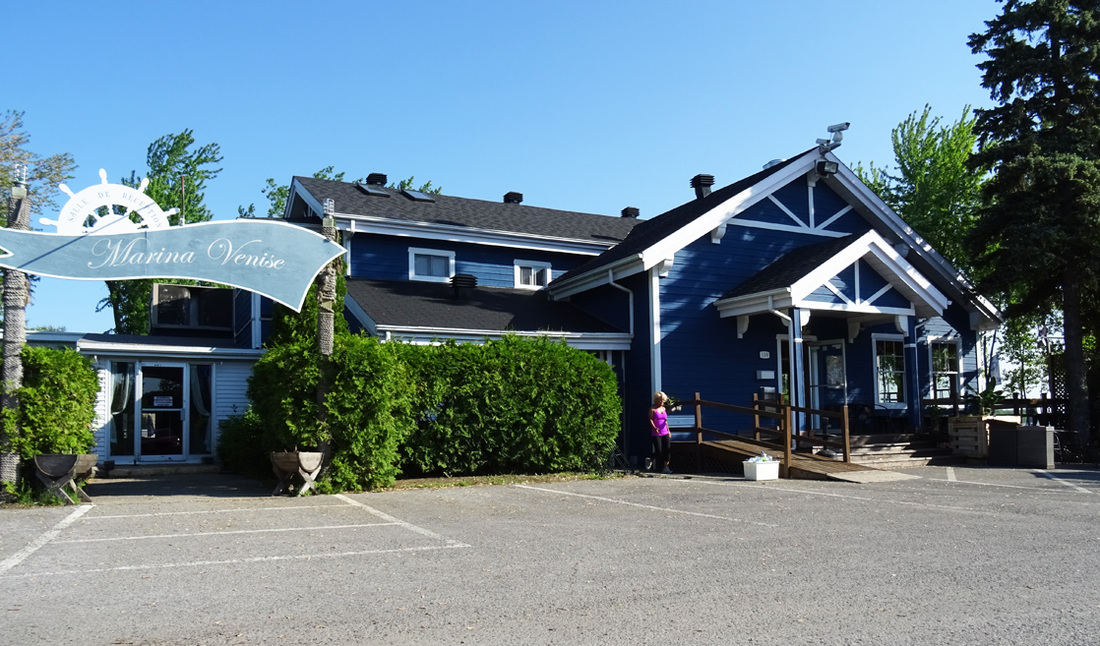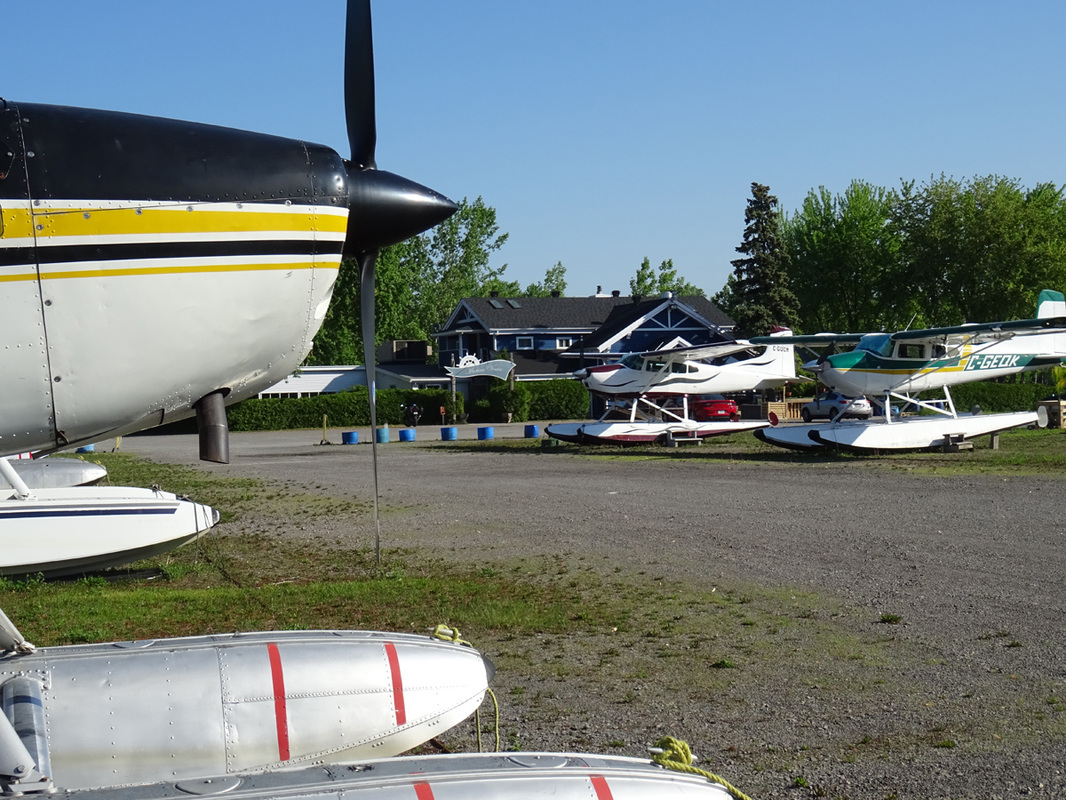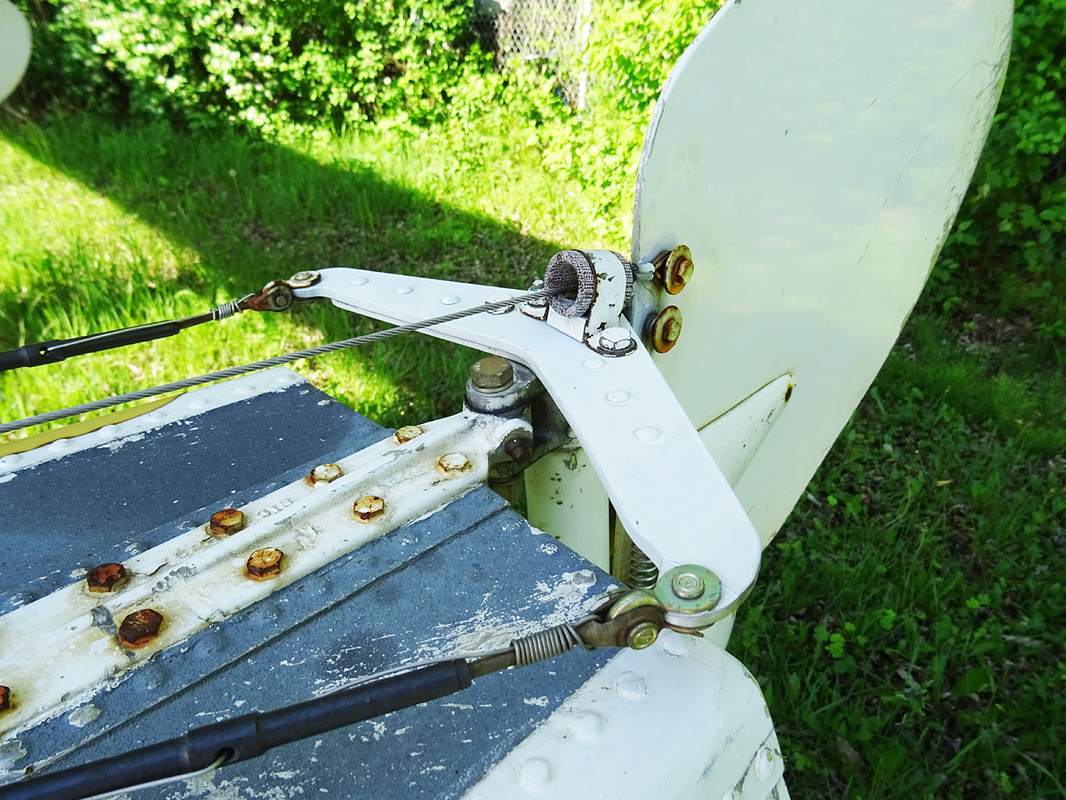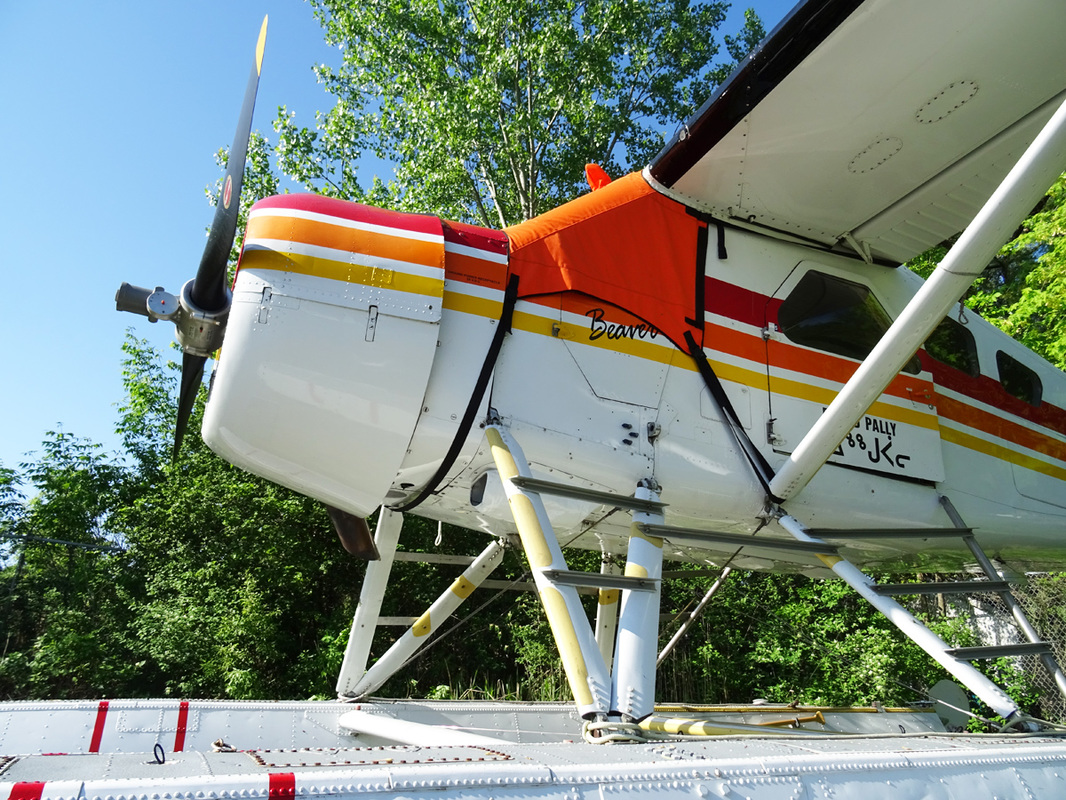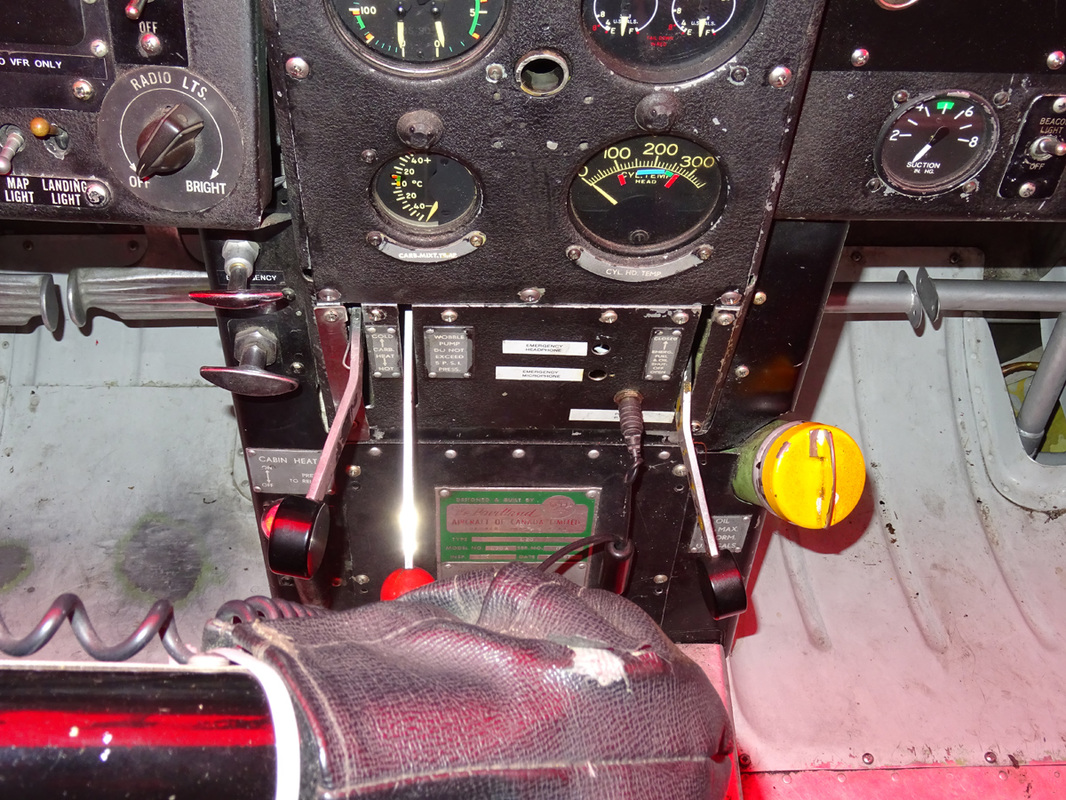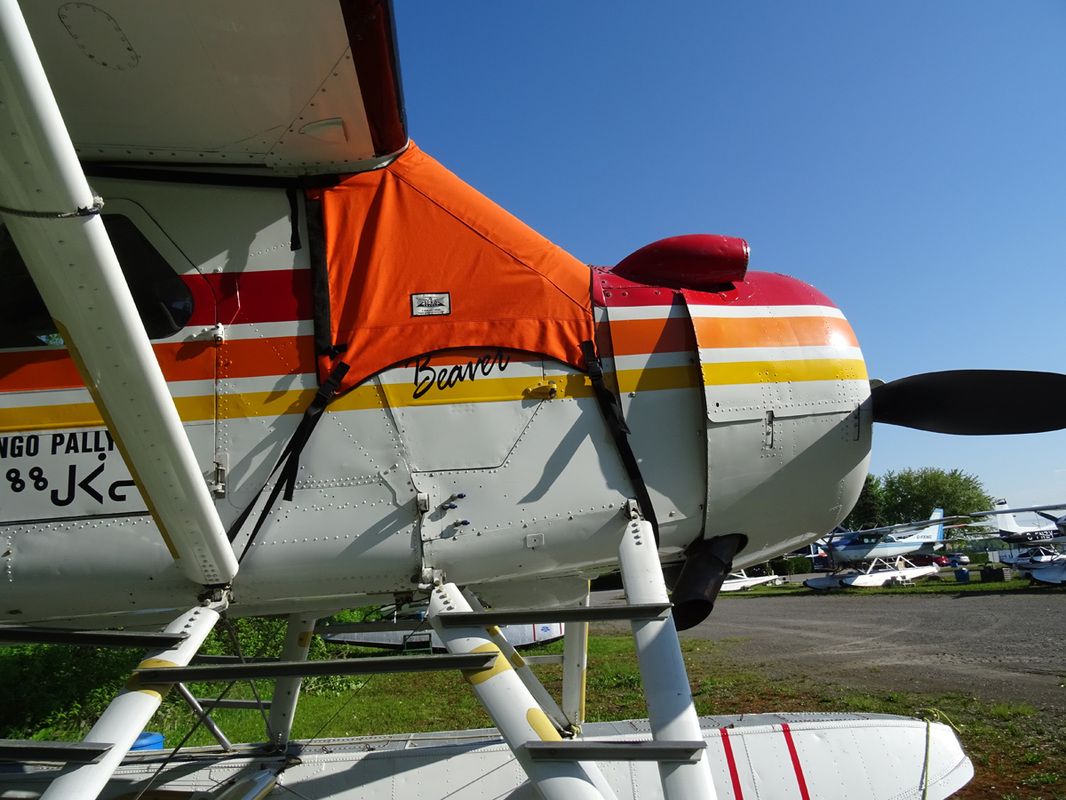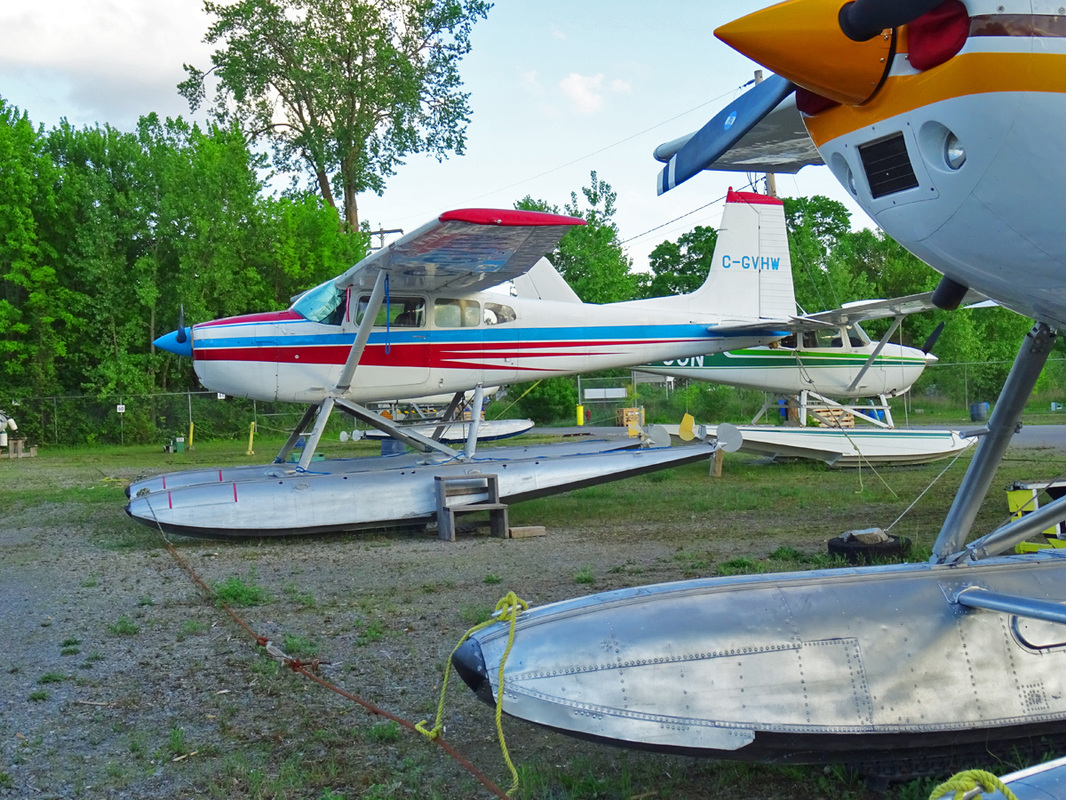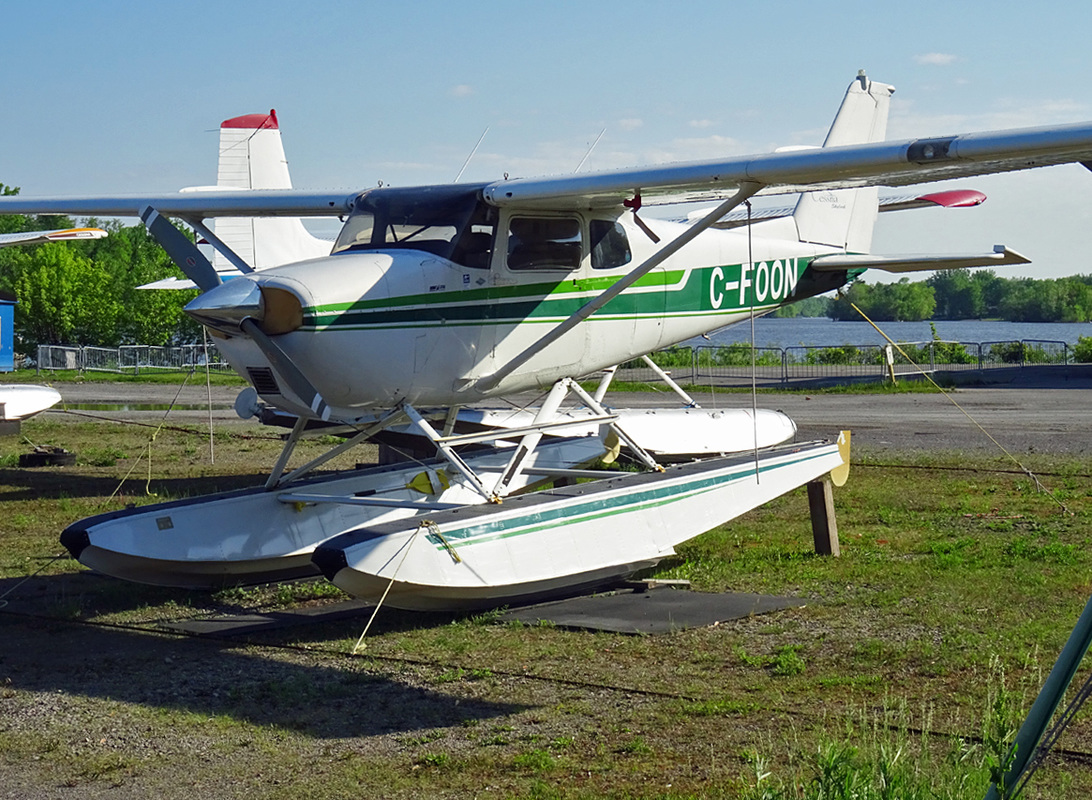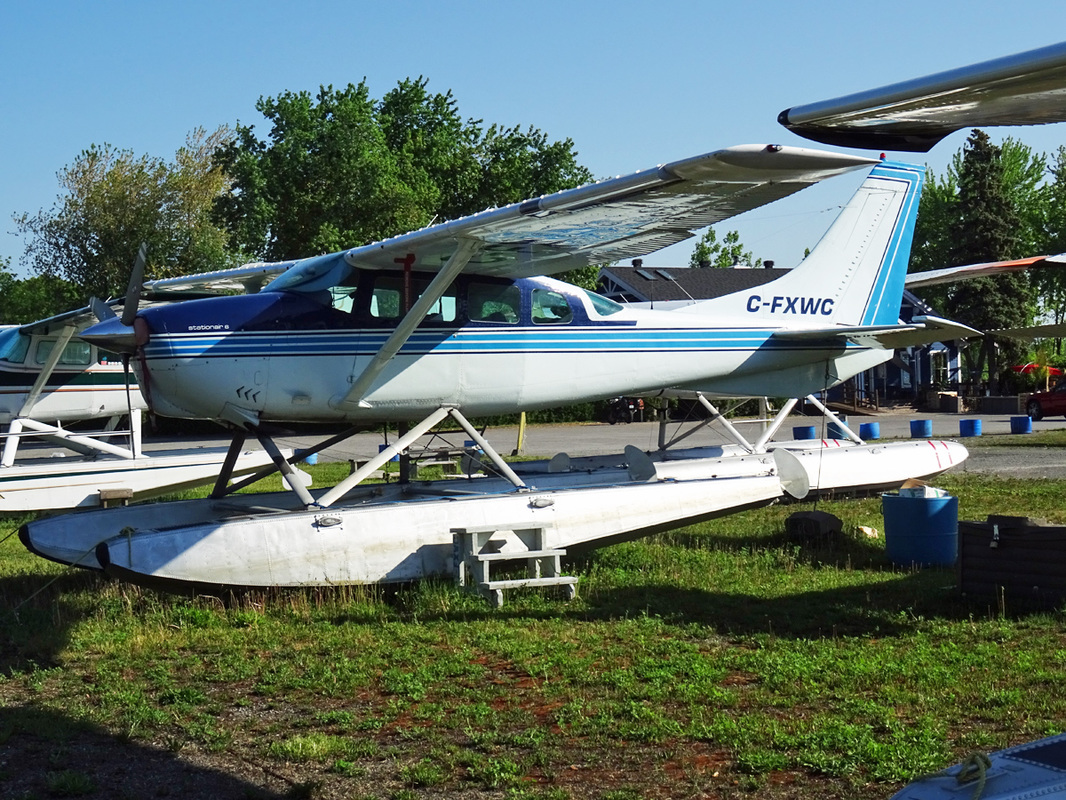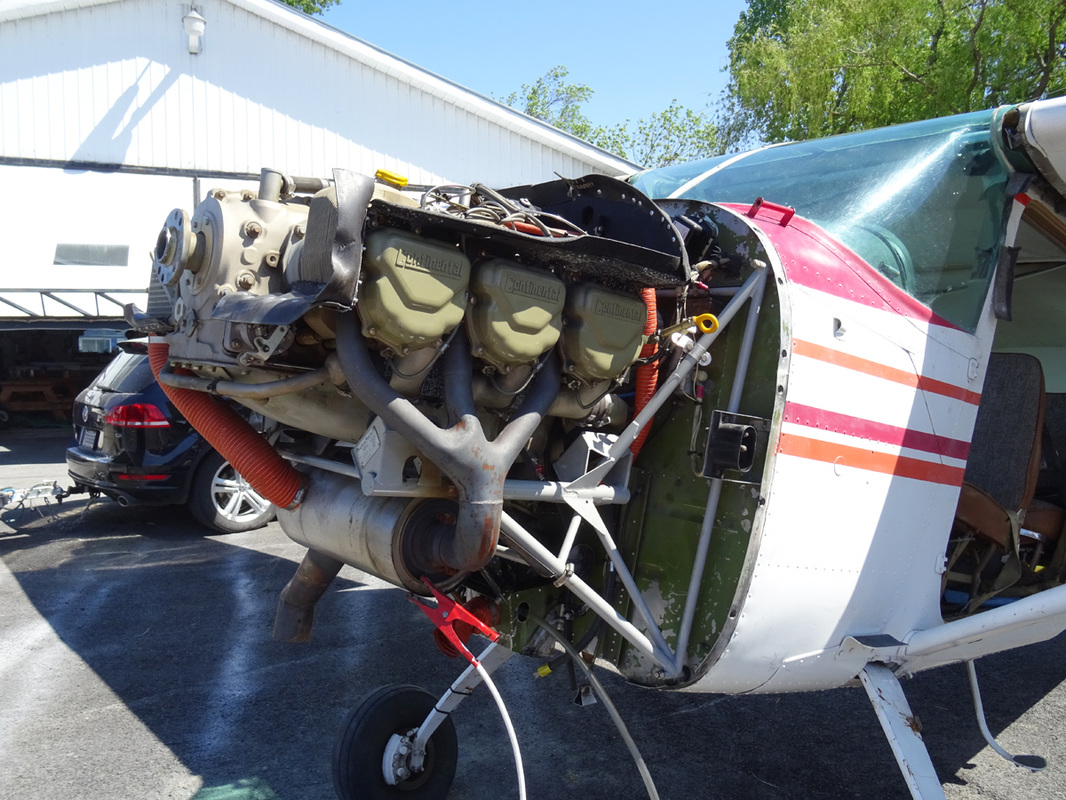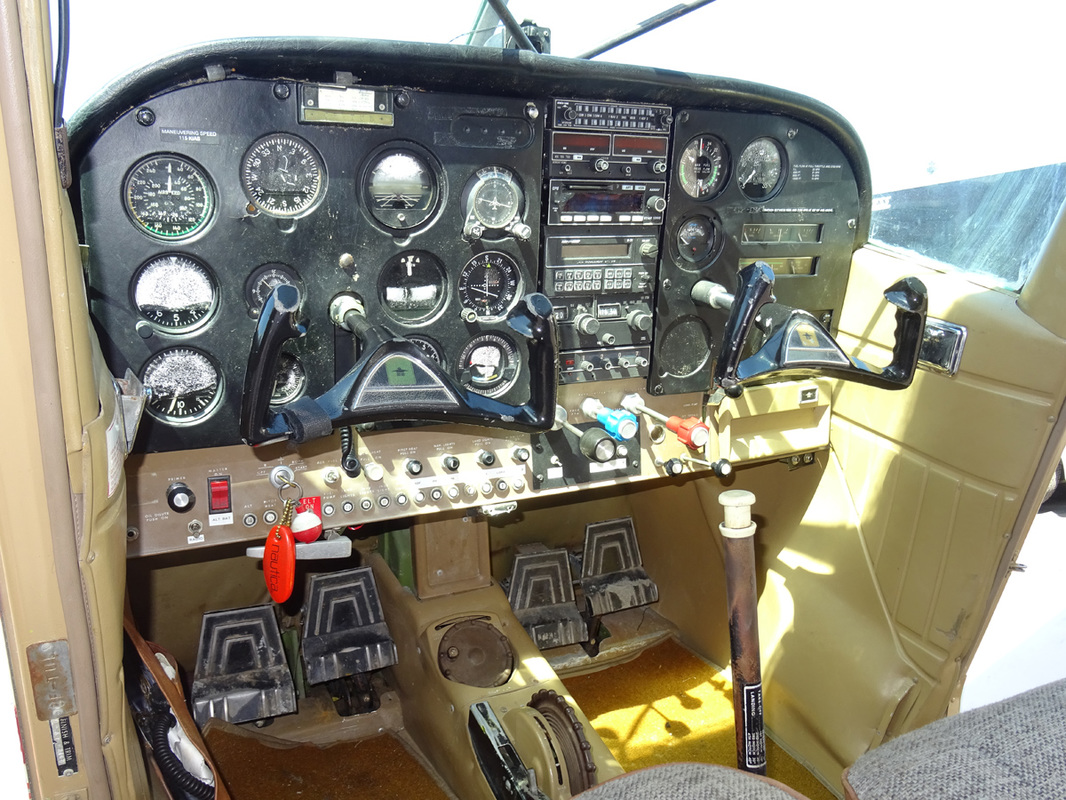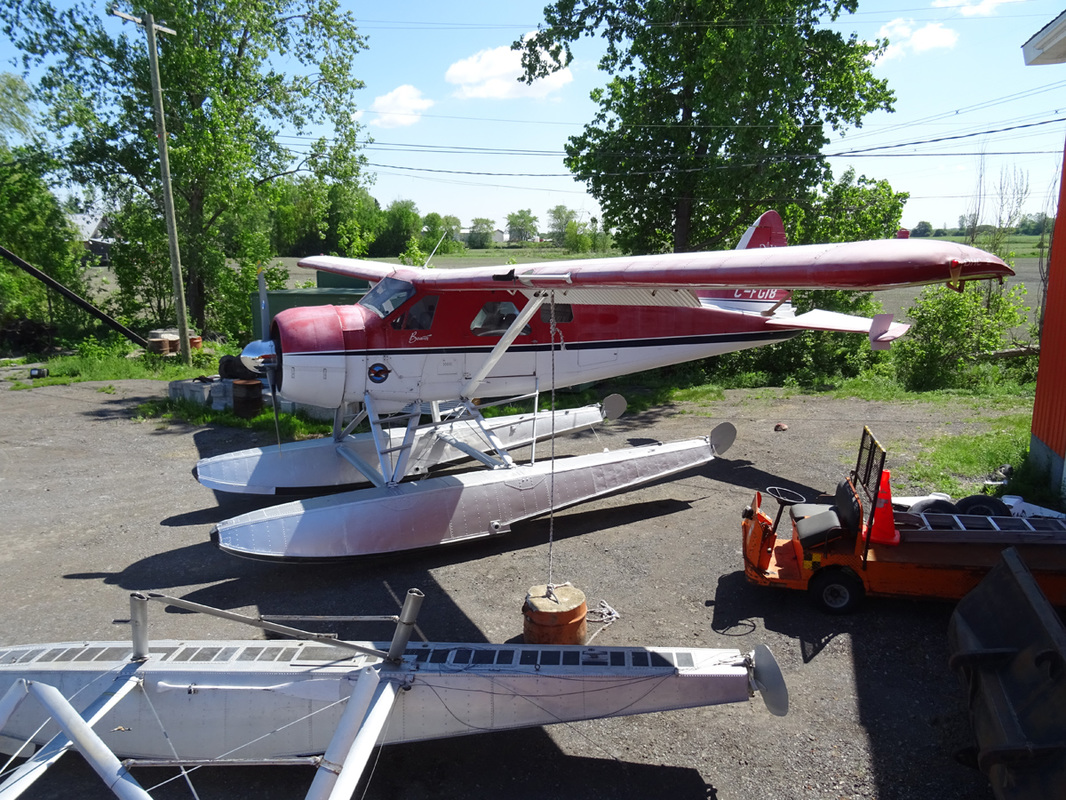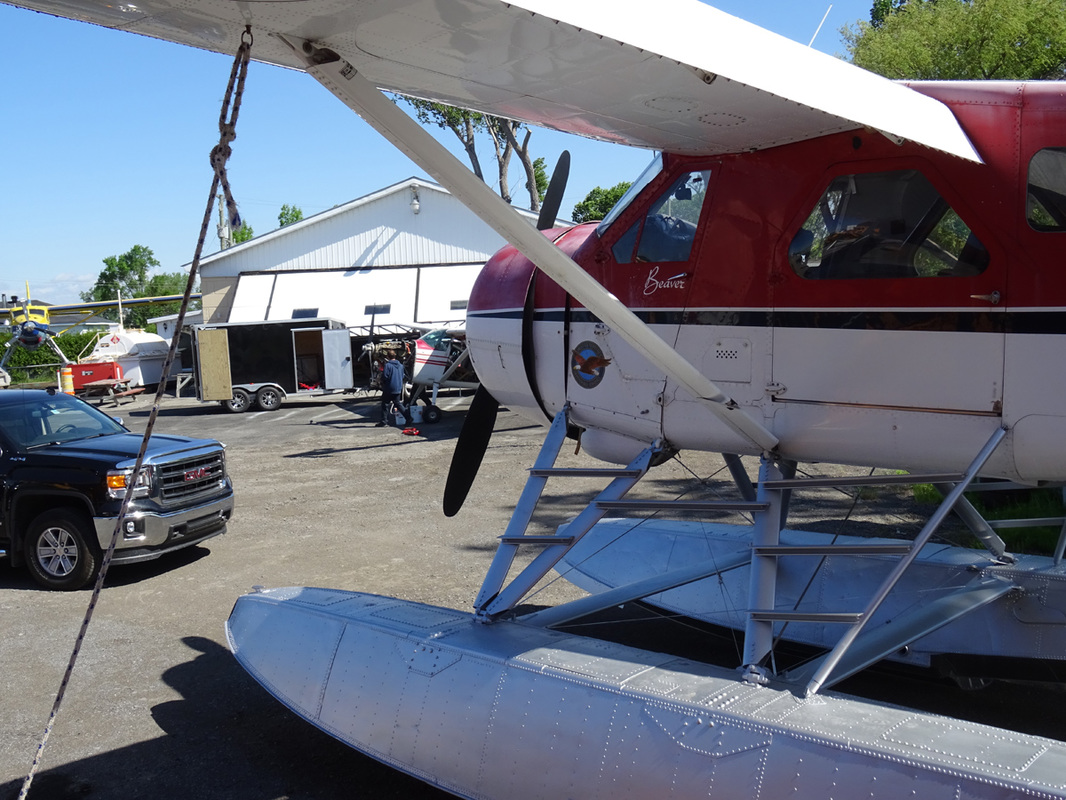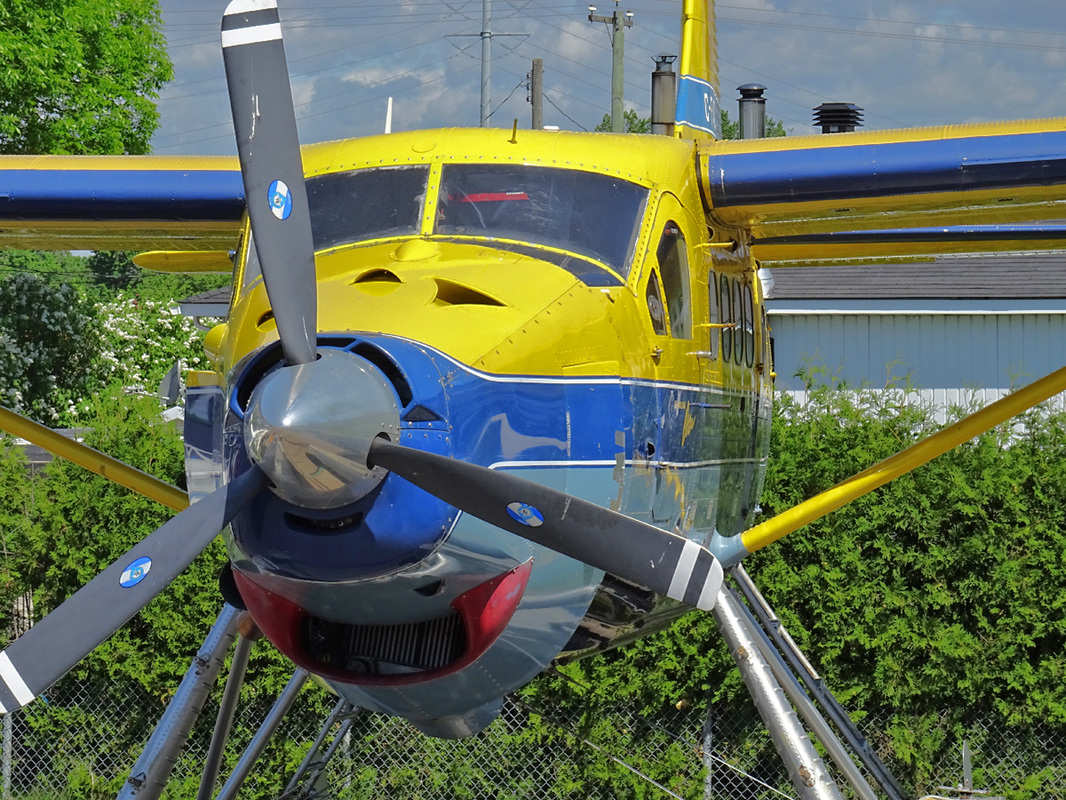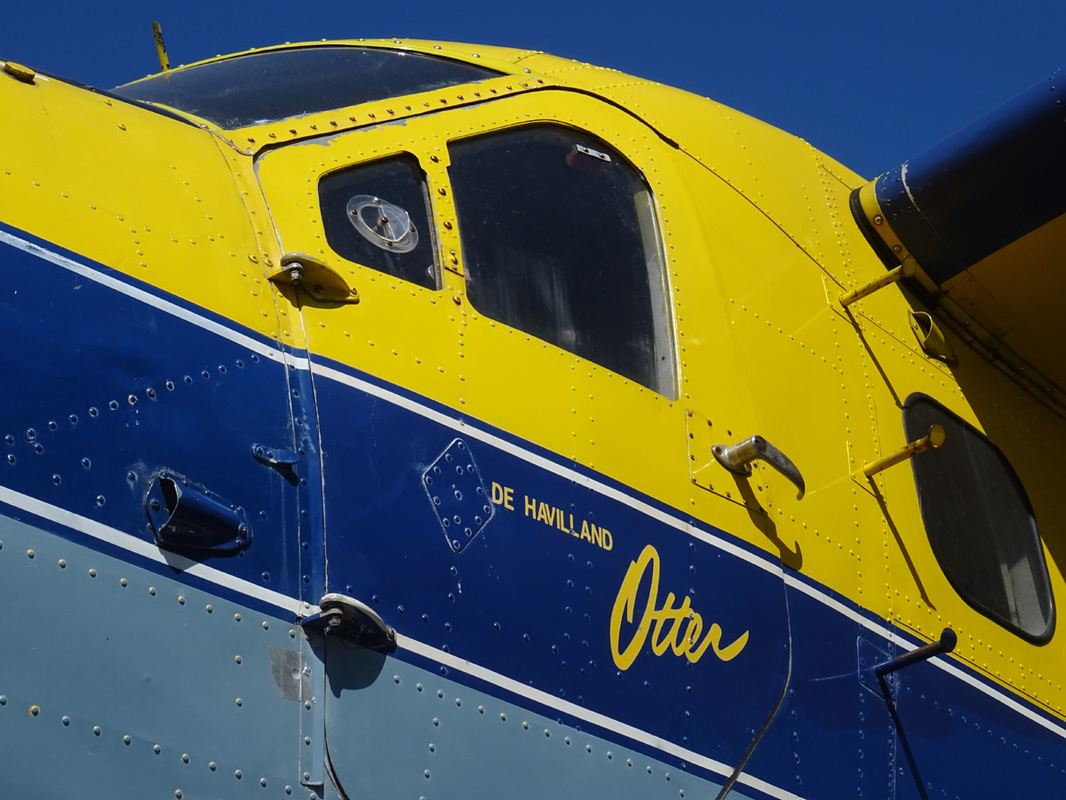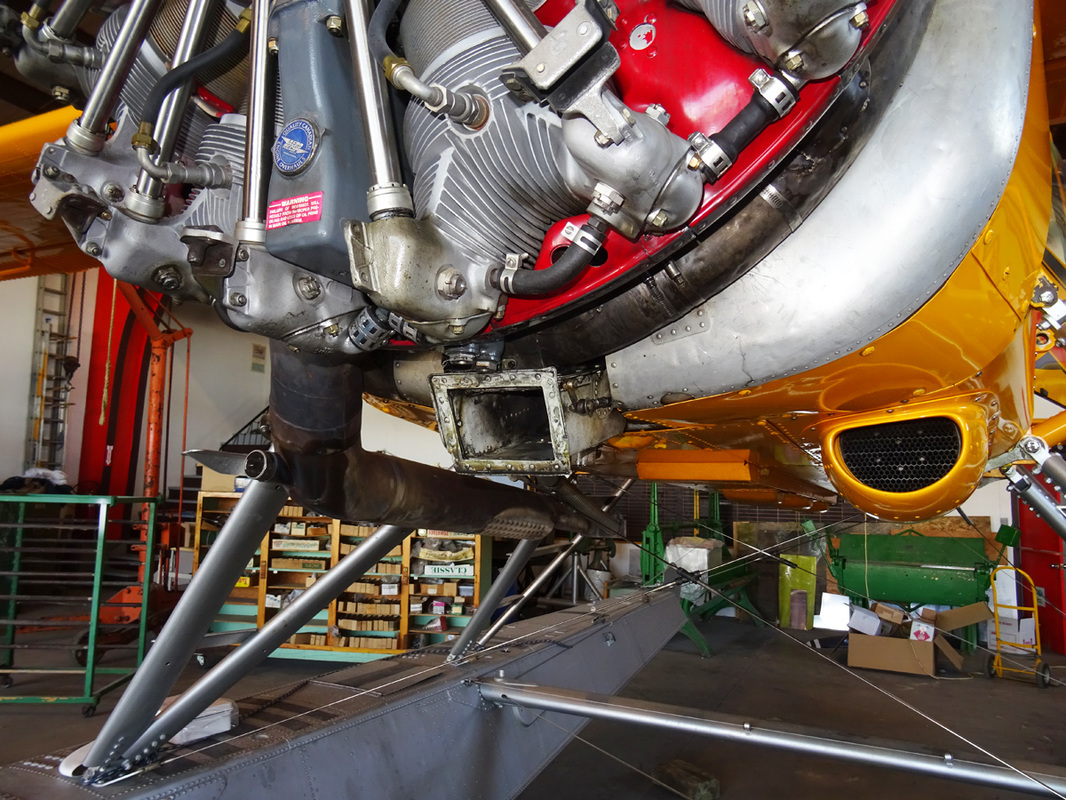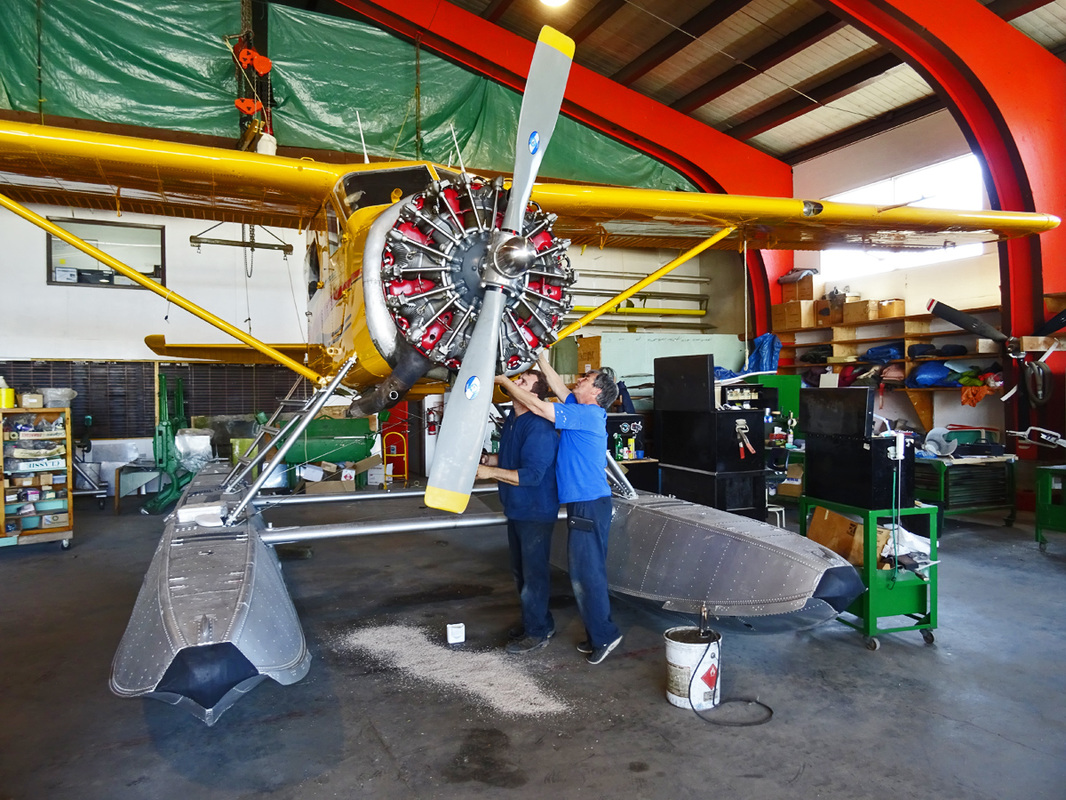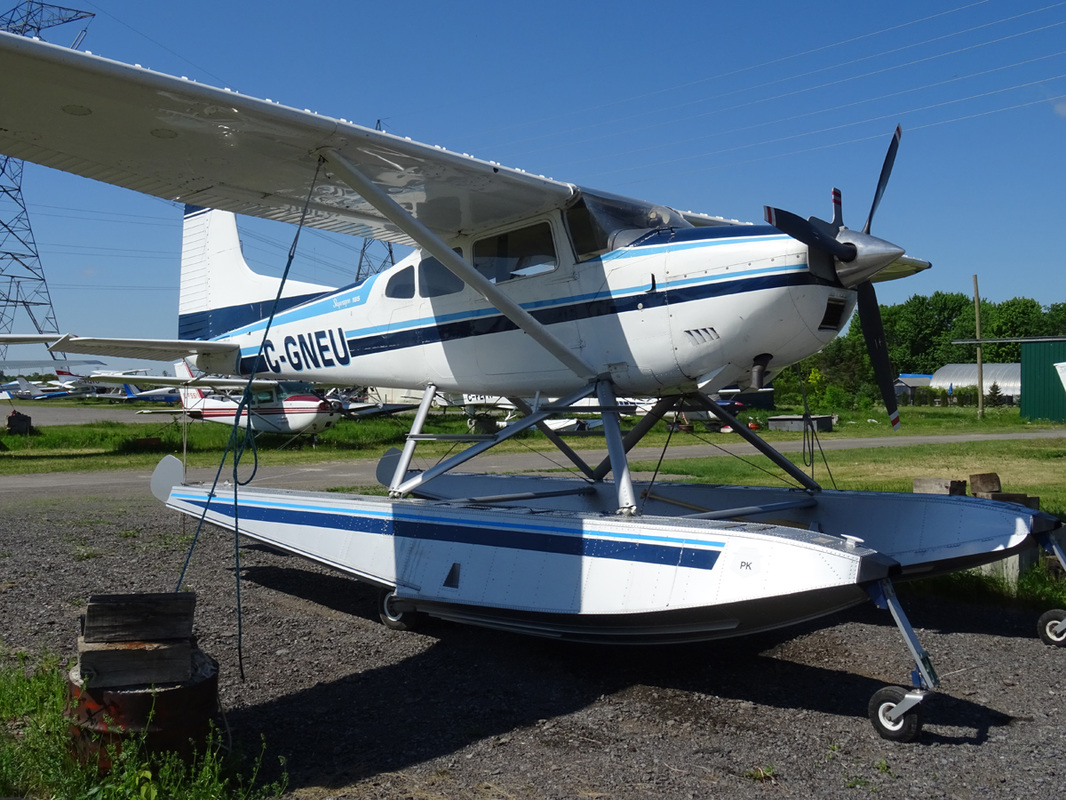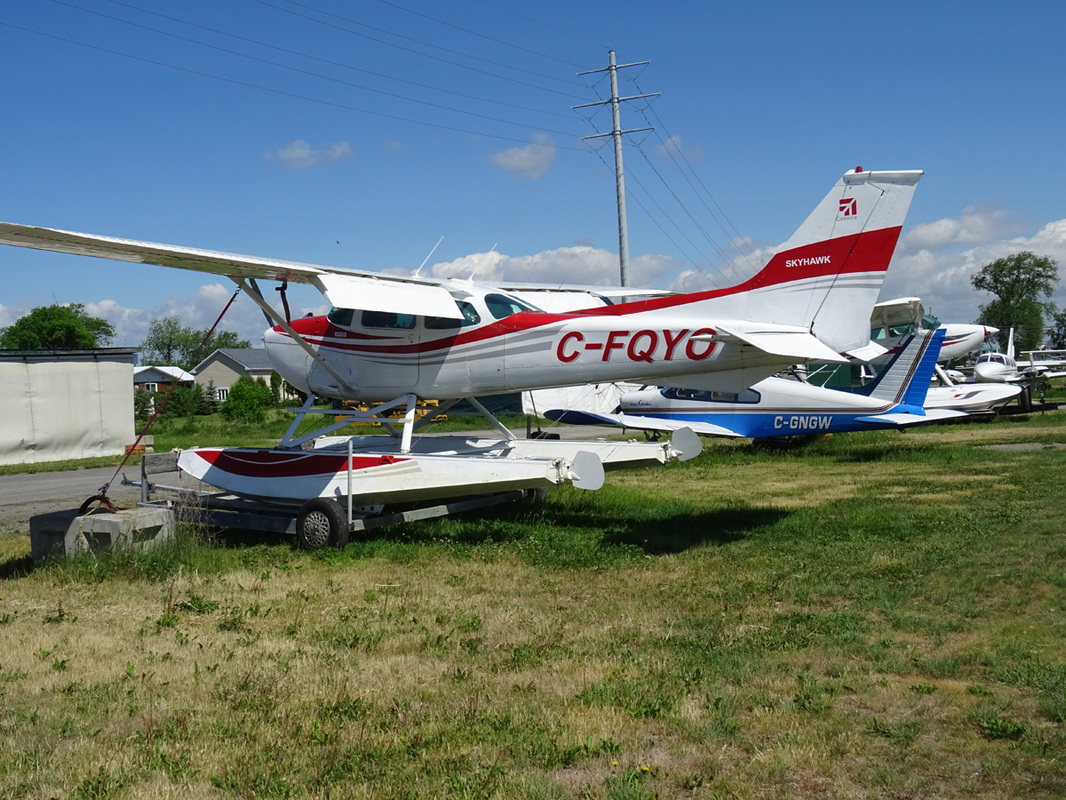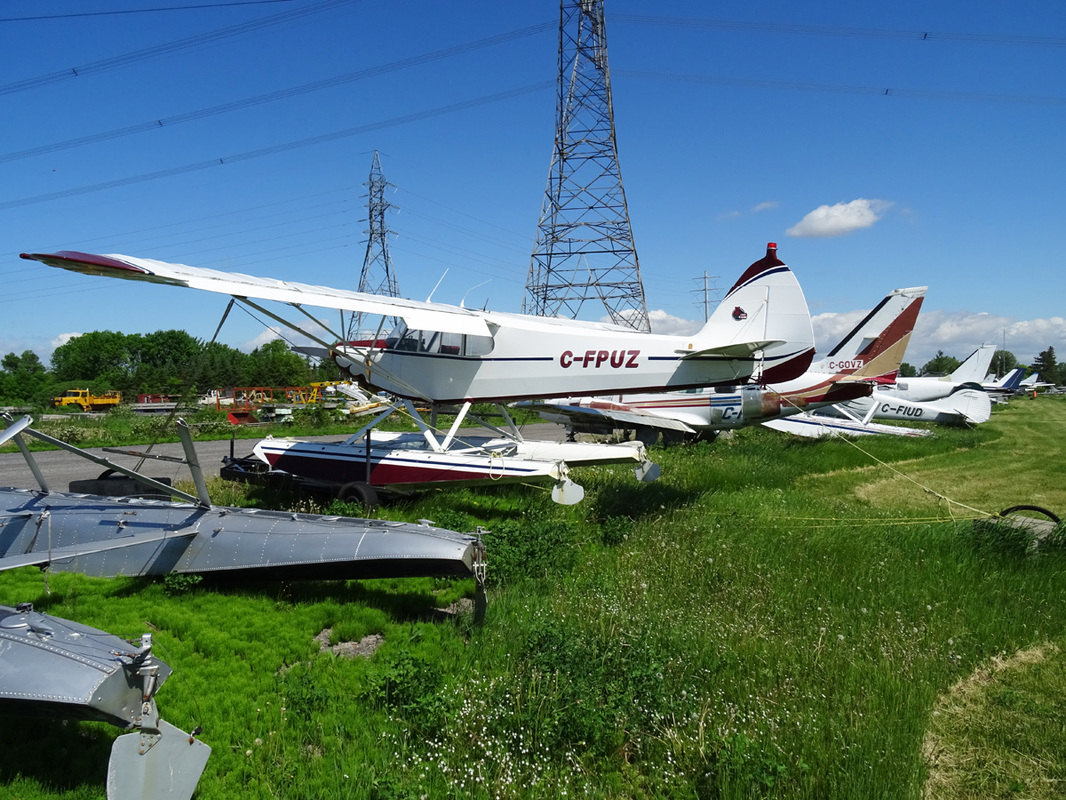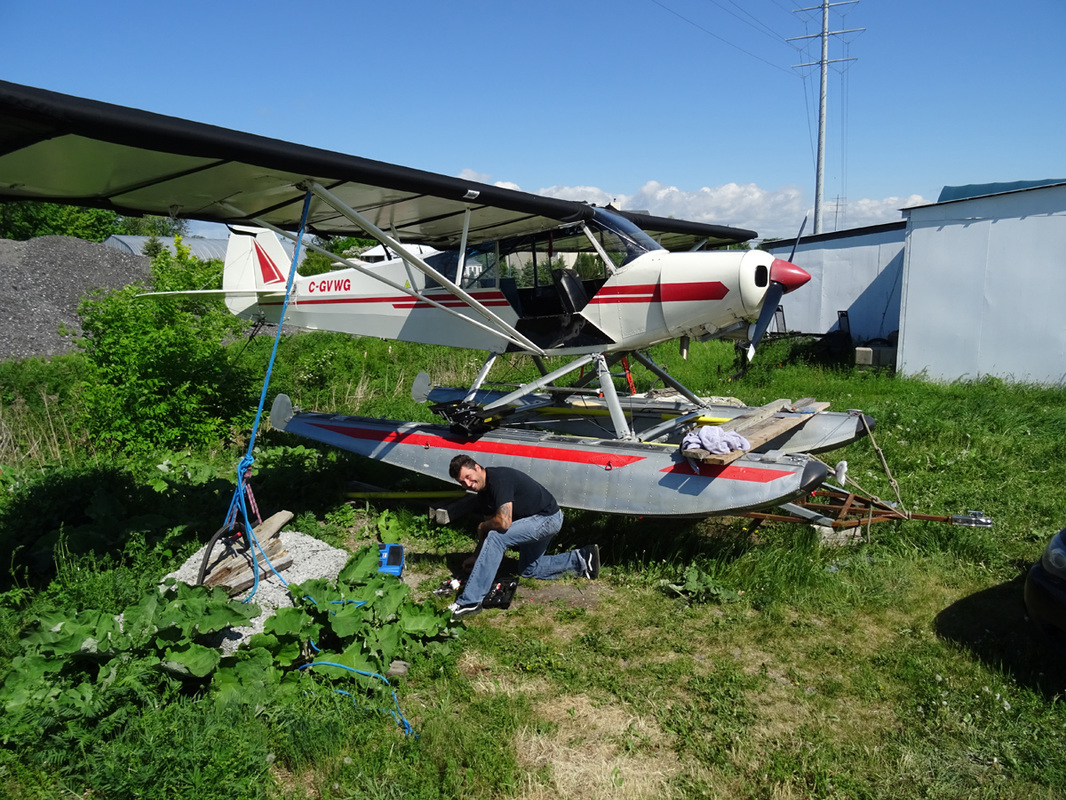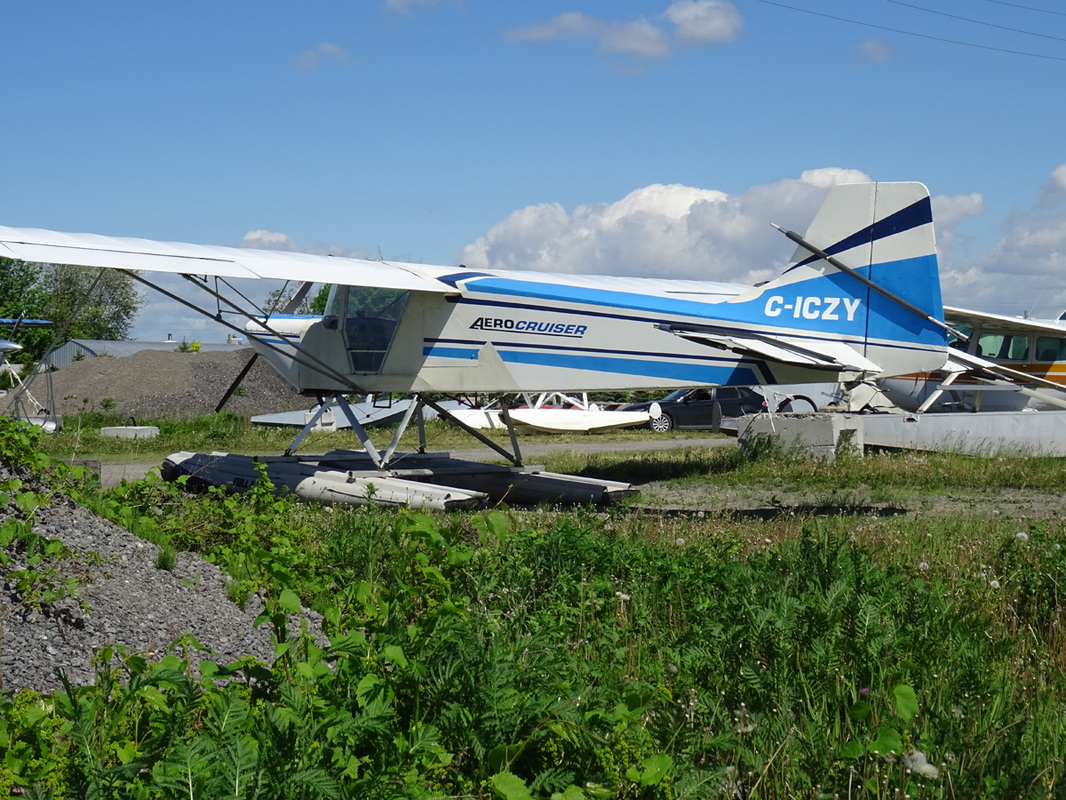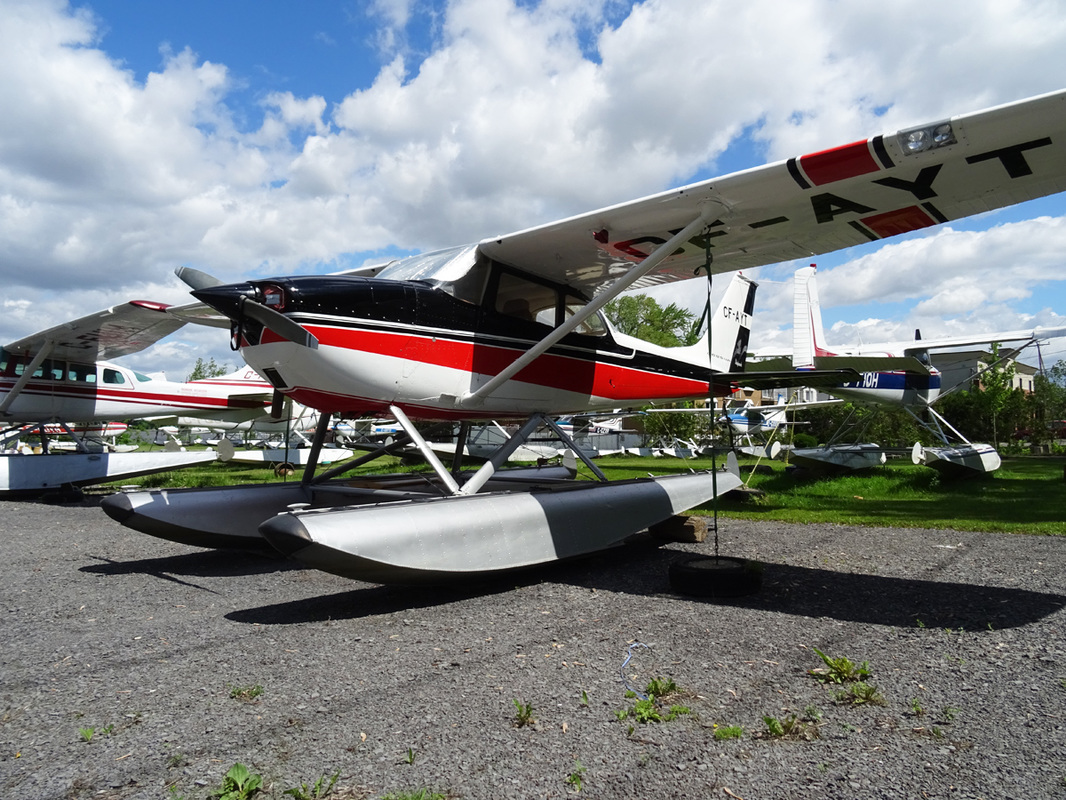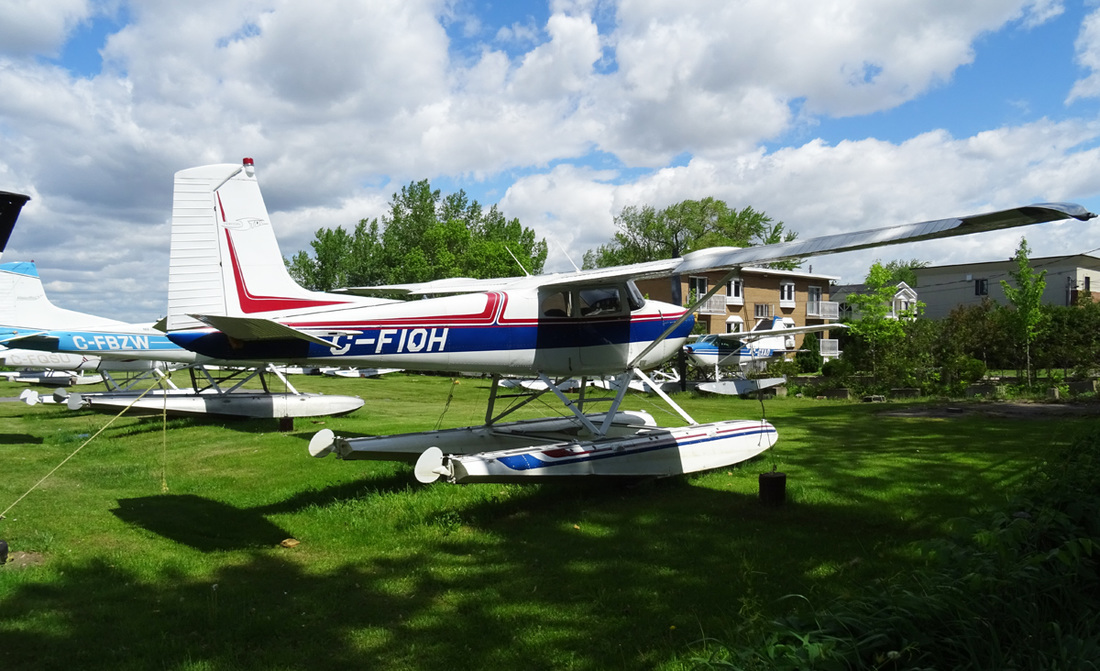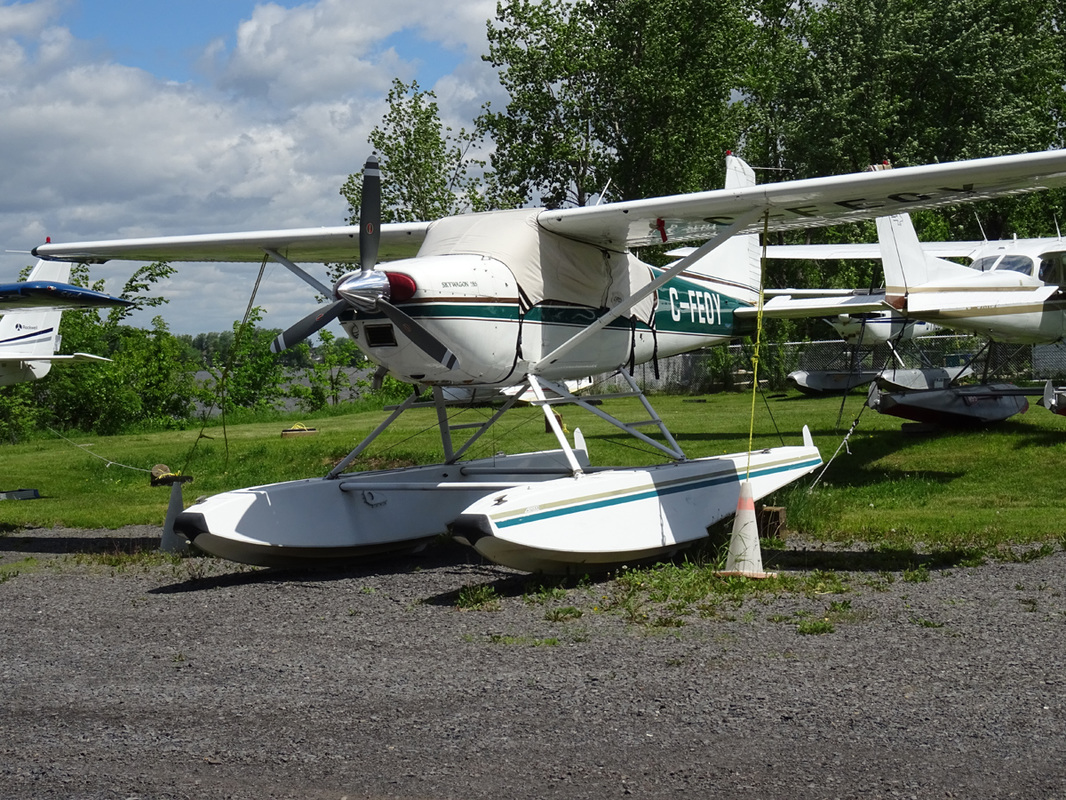Quebec Bush-planes 2016
The Montreal area
By Jan Koppen
When working at Amsterdam-Schiphol airport, one is always surrounded by modern jets. Once in a while, the need to fly Piston-Prop Bush-planes must be fulfilled!
Nowadays the choice is limited. Fortunately, Canada, is a land still with a good number of bush-planes operators. Having visited the Vancouver and Red Lake area several years ago, I opted this year to visit the Montreal, Quebec area.
Nowadays the choice is limited. Fortunately, Canada, is a land still with a good number of bush-planes operators. Having visited the Vancouver and Red Lake area several years ago, I opted this year to visit the Montreal, Quebec area.
|
With a lot of interest I have been reading Danielle Metcalfe-Chenail's book For the Love of Flying - The story of Laurentian Air Services.
For the Love of Flying tells the story of Laurentian Air Services. Drawing on extensive research and interviews with Laurentian's owners , pilots and ground crew, Danielle explores this innovative company's colourful 60-year history from its founding in 1936 with biplanes through the 1990's when it operated twin-engined turboprops. This book if filled with lively flying anecdotes from the cockpits of the world's most recognizable bush planes, including the Beaver, Otter and Sywagons. I enjoyed it so much, that I decided to head for Ottawa Uplands, Maniwaki, Domanin d'Esterel, Saint-Marguerite-du-Lac-Masson, Chateau Montebello and the other places, to see for myself where all the fascinating history of Laurentian Air Service took place. As a Canadian you might ask yourself; - Why is a guy from Europe interested in a Canadian bush-plane operator of the past? - Well, I am fascinated by bush-planes, their hard working owners and staff and ofcourse the history of these operators. |
|
As a kid from the 60/70's I enjoyed the television series 'The Dukes of Hazzard' in which a orange colored Dodge Charger played a starring role. As I always wanted to drive such a car, I treated myself to rent a 2016 Dodge Charger for this upcoming Quebec Bush-plane tour.
The General Lee (sometimes referred to as simply "the General") is the name given to a 1969 Dodge Charger driven in the television series The Dukes of Hazzard by the Duke cousins, Bo and Luke, along with cousins Coy and Vance. It is known for its signature horn, its police chases, stunts — especially its long jumps — and for having its doors welded shut, leaving the Dukes to climb in and out through the windows. The car's name is a reference to American Civil War general Robert E. Lee. It bears a Confederate flag (a rectangular variant of the square battle flag of Lee's Army of Northern Virginia) on its roof, and also has a horn which plays the first twelve notes of the song "Dixie". That Monday in June, I fired up my mighty, fire-red 2015 Dodge Charger and I drove to my first Port-of-Call; Marina-Venise in north-west Montreal. |
Montreal Marina-Venise
15+ floatplanes at rest in the morning sun at beautiful located Marina Venise.
The De Havilland Aircraft Company was a British aviation manufacturer founded in 1920 of which Geoffrey de Havilland had been chief designer. He proposed the continuing to name the DHC line of aircraft after Canadian mammals.
In September, 1946, de Havilland put together a design team. The new aircraft was specifically designed to be all-metal, unlike older designs like the famous Noorduyn Norseman. He used steel from the engine to the firewall, heavy aluminum truss frames with panels and doors throughout the front seat area, lighter trusses toward the rear and all monocoque construction aft. At the time de Havilland Canada was still a British company and there were plans to fit the evolving design with a British engine. This limited power, so the wing area was greatly increased in order to maintain STOL performance. When Pratt & Whitney Canada could buy war-surplus 450 hp (340 kW) Wasp Jr. engines at a low price, the aircraft ended up with extra power as well as the original long wing. The result was unbeatable STOL performance for an aircraft of its size.
In September, 1946, de Havilland put together a design team. The new aircraft was specifically designed to be all-metal, unlike older designs like the famous Noorduyn Norseman. He used steel from the engine to the firewall, heavy aluminum truss frames with panels and doors throughout the front seat area, lighter trusses toward the rear and all monocoque construction aft. At the time de Havilland Canada was still a British company and there were plans to fit the evolving design with a British engine. This limited power, so the wing area was greatly increased in order to maintain STOL performance. When Pratt & Whitney Canada could buy war-surplus 450 hp (340 kW) Wasp Jr. engines at a low price, the aircraft ended up with extra power as well as the original long wing. The result was unbeatable STOL performance for an aircraft of its size.
The aircraft is powered by a Pratt & Whitney ‘Wasp Junior’ model R-985SB3 nine-cylinder single-row radial engine, rated at 400 BHP at 5,000 ft altitude. The engine drives a Hamilton-Standard constant-speed propeller; crankshaft and propeller rotation being clockwise. Propeller diameter measures 8 ft. 6 in.
|
A real work horse
In the immediate post-war era, de Havilland Canada management turned to the civilian market for continued work, aware that military contracts were unlikely to guarantee business. The company began an extensive program of collecting requests from bush pilots in order to understand what they needed in a new aircraft. Almost without variation, the pilots asked for tremendous extra power and STOL performance in a design that could be easily fitted with wheels, skis, or floats. Poor cruise performance seemed no issue. Other suggestions were seemingly mundane but important in the bush plane world; for instance, full-sized doors were installed on both sides of the aircraft so it could be easily loaded no matter which side of a dock it tied up on. The doors were also made wide enough to allow for a 170 liter (45 gallon) drum to be rolled up into the aircraft. "Pengo Pally" means “I miss you” in the Inuktitut language and this message (in English and Inuktitut) was stencilled on the fuselage of Johnny May’s De Havilland Beaver, as a personal note to his wife Louisa.
Johnny May, was born in 1947 in Kangiqsualujjuaq to Bob Martin May of Manitoba and an Inuk mother named Nancy. Johnny decided to become a pilot when his was six years old, during a flight to his father’s fishing camp when the pilot let Johnny briefly take the controls. Right on the spot, little Johnny knew he wanted to fly for a living. He flew his first solo flight at age 16 and has since embarked on a career that spanned well over five decades. For most of his career, Johnny May flew in areas where topographical maps didn’t exist, and where the conditions were hostile and filled with danger. It was a vast and uncharted frontier where he landed on tundra or ice, depending on the time of year and the weather. You can learn a lot more about Johnny May and his adventures by viewing a full feature documentary called “The Wings of Johnny May” which is available for download at the National Film Board. This film not only depicts Johnny’s adventures, it brings out so much more... the harsh beauty of the Nunavik territory, history of the the Inuit people going through dramatic“ends of the world” events such as the arrival of the snowmobiles which lead to a change from a traditional to a more sedentary lifestyle and more recently, the dramatic effects of climate change on the Arctic ecosystem. Interestingly, despite ample stories and adventures, the makers of the film said it was difficult to convince the very modest Johnny May to agree to a film about his life. |
|
C-GRHF started its career with delivery in 1957 to the US Army in Germany. After her military career was over, she was stored at Coleman Barracks, Mannheim-Sandhofen, Germany. She was imported to Canada by B & M Aviation in 1973 and was registered as C-GMAY. This Beaver serviced bush plane operator Johnny May’s Air Charters Ltd for many years. Canada Inc. purchased this well maintained Beaver in 2013 and registrated her C-GRHF.
|
The oil tank is located aft of the fire-wall and is serviced from inside the cockpit through a filler (yellow cap) at the base of the pedestal. The capacity is 5 ¼ imperial gallons.
Fuel is contained in three tanks under the cabin floor which are used separately. They are serviced through three filler necks in a filler compartment protected by a hinged door on the forward left-hand side of the fuselage, adjacent to the cockpit door. For long range operation non-jettisonable wing tip tanks may be installed to replace conventional wing tips. Fuel from these tanks is gravity fed to the front tank. |
A 7th generation 'General Lee' in front of Pengo Pally!
|
Cool to catch this old girl. Aircraft built in 1952!
C-FAEG is a Cessna 170B. The Cessna 170 is a light, single-engined, general aviation aircraft produced by the Cessna Aircraft Company between 1948 and 1956. The Cessna 170 began it’s life looking much like it’s little brother, the Cessna 140. In fact, the 1948 C170 is quite often mistaken for the smaller two-place C140 by the casual observer. In 1948, Cessna expanded and stretched the 140 to make it a four-place aircraft and called it the 170. It had no dorsal fin, had fabric-covered wings, vee-type wing struts and three C140 fuel tanks to give it the necessary range for it’s larger engine. The engine used was a Continental C145 (later designated the O-300A) and would be used throughout the entire production run of Cessna 170s. |
|
|
The Cessna 170B was introduced in 1952 and continued in production with several changes until production on the series ended in 1956. The most obvious change from the 170/170A is the large semi-Fowler flaps similar to those used on the L-19. The flaps were labeled “Para-lift” by Cessna, but the term “barn door” is the more common description. The flaps originally had four settings: 0, 20, 30 and 40 degrees. Beginning in 1955, Cessna added a 10 degree flap setting.
Specifications 170B General characteristics Crew: 1 Capacity: 3 passengers Length: 24 ft 11 1⁄2 in (7.607 m) Wingspan: 36 ft (11 m) Height: 6 ft 7 in (2.01 m) Wing area: 174 sq ft (16.2 m2) Aspect ratio: 7.46:1 Airfoil: NACA 2412 Empty weight: 1,205 lb (547 kg) Gross weight: 2,200 lb (998 kg) Fuel capacity: 42 US gal (160 L; 35 imp gal) Powerplant: 1 × Continental C-145-2 air-cooled flat-six, 145 hp (108 kW) Performance Maximum speed: 140 mph (225 km/h; 122 kn) Cruise speed: 120 mph (104 kn; 193 km/h) Stall speed: 52 mph (45 kn; 84 km/h) Endurance: over 4.5 hours Service ceiling: 15,500 ft (4,724 m) Rate of climb: 690 ft/min (3.5 m/s) |
|
|
During the late 1940s through the mid-1950s over 5,000 Cessna 170s were manufactured and well over half that number survive today. This alone should indicate that this aircraft has certain qualities that make it a desirable aircraft to own and has also gained it recognition as a Neo-Classic in various aircraft organizations.
|
Floats or seaplane pontoons are a landing gear adaptation for an aircraft in which existing wheels are removed and replaced with hollow pontoons, supported by struts and spreaders, and attached to the fuselage with fittings that usually use the landing gear points.
The airplane must first have a “seaplane kit” in it. This usually consists of fuselage beef-ups, and a vee-brace in the cockpit. If the seaplane kit is already in the plane, installing floats for the first time will take from one to three days. After that, changeovers between wheels and floats can usually be done in a few hours.
The airplane must first have a “seaplane kit” in it. This usually consists of fuselage beef-ups, and a vee-brace in the cockpit. If the seaplane kit is already in the plane, installing floats for the first time will take from one to three days. After that, changeovers between wheels and floats can usually be done in a few hours.
C-FXGN is a 1968 built Cessna 180H Skywagon.
Cessna introduced the heavier and more powerful 180 as a complement to the Cessna 170. It eventually came to be known as the Skywagon. The prototype Cessna 180, first flew on May 26, 1952. The Cessna 180 is a four- or six-seat, fixed conventional gear general aviation airplane which was produced between 1953 and 1981. Though the design is no longer in production, many of these aircraft are still in use as personal aircraft and in utility roles such as bush flying.
The six seat 180H is powered by a 230 hp (172 kW) Continental O-470-L or O-470-R and was first certified on 17 June 1964.
Optional was a 300 pound external cargo pod for the 1970 C-180H
Among the more significant changes of the 1968 Model 180H were:
· New baggage door.
· Fuel strainer cable moved to oil filler door.
Cessna introduced the heavier and more powerful 180 as a complement to the Cessna 170. It eventually came to be known as the Skywagon. The prototype Cessna 180, first flew on May 26, 1952. The Cessna 180 is a four- or six-seat, fixed conventional gear general aviation airplane which was produced between 1953 and 1981. Though the design is no longer in production, many of these aircraft are still in use as personal aircraft and in utility roles such as bush flying.
The six seat 180H is powered by a 230 hp (172 kW) Continental O-470-L or O-470-R and was first certified on 17 June 1964.
Optional was a 300 pound external cargo pod for the 1970 C-180H
Among the more significant changes of the 1968 Model 180H were:
· New baggage door.
· Fuel strainer cable moved to oil filler door.
|
C-FNZY is a 1962 built 180E Skywagon. A classic Cessna!
The four seat 180E was certified on 21 September 1961. Among the more significant changes of the 180E were:
|
|
Cessna 180 Skywagon: The Pickup Truck of the Air!
C-GVHW is a 1972 built Cessna 180H Skywagon. The airframe of the 180 is all-metal, constructed of aluminum alloy. The fuselage is a semi-monocoque structure, with exterior skin sheets riveted to formers and longerons. The strut-braced wings, likewise, are constructed of exterior skin sheets riveted to spars and ribs. The landing gear of the 180 is in a conventional arrangement, with main gear legs made of spring steel, and a steerable tailwheel mounted on a hollow tapered steel tube. |
|
Skywagons parked and waiting to fulfill their missions of hauling people and cargo in and out of otherwise inaccessible outposts.
C-GFYB is a 1976 built Cessna 180J Skywagon modified with an Horton STOL kit. Cessna 180s produced between 1953 and 1963 have two side windows, while 1964 to 1981 models feature three side windows, as they use the same fuselage as the Cessna 185.
Among the more significant changes of the six seat 1976 Model 180J were:
· Primary airspeed indication changed to knots.
· Flush folding 5th and 6th seats introduced.
· Flap extension speed increased to 120 knots.
· McCauley main wheels and brakes.
Optional were the bubble window for the cabin door(s) in the 1974 C-180J and camber-lift wing with bonded leaded edges, and cowl-mounted landing/taxi lights in the 1973 C-180J.
Among the more significant changes of the six seat 1976 Model 180J were:
· Primary airspeed indication changed to knots.
· Flush folding 5th and 6th seats introduced.
· Flap extension speed increased to 120 knots.
· McCauley main wheels and brakes.
Optional were the bubble window for the cabin door(s) in the 1974 C-180J and camber-lift wing with bonded leaded edges, and cowl-mounted landing/taxi lights in the 1973 C-180J.
|
According Horton Inc.; - the Horton STOL Conversion will give the advantage of taking-off and landing at a slower speed, the ability to get out of grass strips easier, obtain better performance at high altitudes, with better aileron control at low speeds, reduce the tendency to spin and reduce the stall speed.
What are floats made of? Over the years floats have been made out of wood, aluminum, fiberglass, composite or even fabric. The best service seems to be achieved from the aluminum, some still in service for 50+ years! Tough, fexible, easy to repair, light, and relatively inexpensive, aluminum meets the varied and critical demands of water takeoffs and landings. Boats are one thing; airplanes are another. Seaplane pontoons live in a world between the two, and must take the beatings delivered by both worlds. That’s why aluminum has been the standard for floats for over 50 years. |
|
Most Cessna 180s eventually wind up on floats.
Most Cessna 180s eventually wind up on floats. Adding only 36 pounds to the empty weight, a seaplane kit includes the hidden hardware required to convert a landplane to a seaplane and the strengthening needed for the airframe to endure seaplane operations. The seaplane kit also includes corrosion-proofing that is added during construction, an advantage even for owners with no intention of flying floats. The kit also ups the maximum allowable gross weight from 2,800 to 2,950 pounds.
C-GUQW is a 1977 built Cessna 180K Skywagon. The six seat 180K is powered by a 230 hp (172 kW) Continental O-470-U and was first certified on 19 August 1976.
Among the more significant changes of 1977 Model 180K were:
· Engine changed to high compression O-470-U.
· Vernier mixture control introduced.
· Heater plenum relocated to firewall.
· Strengthened tail wheel.
· Basic flight instruments in "T" configuration.
· First year for McCauley tail wheel and stronger tail wheel gear spring tube.
C-GUQW is a 1977 built Cessna 180K Skywagon. The six seat 180K is powered by a 230 hp (172 kW) Continental O-470-U and was first certified on 19 August 1976.
Among the more significant changes of 1977 Model 180K were:
· Engine changed to high compression O-470-U.
· Vernier mixture control introduced.
· Heater plenum relocated to firewall.
· Strengthened tail wheel.
· Basic flight instruments in "T" configuration.
· First year for McCauley tail wheel and stronger tail wheel gear spring tube.
C-FDCF is a 1962 built Cessna 185A.
Cessna continued to develop its popular tailwheel 180 design. In 1961 the company added more power. The result was the Cessna 185, which at first had a 260-horsepower fuel-injected Continental IO-470 and in 1966, a 300-horsepower Continental IO-520. The more powerful Cessna 185 was identical to the Cessna 180 except for a strengthened fuselage; an additional window; an enlarged dorsal fin to help keep the additional power in check; and, of course, a significant increase in performance. The 300-horsepower Skywagon became one of the few airplanes that can carry a useful load greater than its own empty weight. The 185A is a six seat Skywagon powered by a 260 hp (194 kW) Continental IO-470-F and was certified on 20 September 1961.
The Robertson STOL kit, with its “camber lift” wing is popular among bush pilots and helpful for floatplanes.
Cessna continued to develop its popular tailwheel 180 design. In 1961 the company added more power. The result was the Cessna 185, which at first had a 260-horsepower fuel-injected Continental IO-470 and in 1966, a 300-horsepower Continental IO-520. The more powerful Cessna 185 was identical to the Cessna 180 except for a strengthened fuselage; an additional window; an enlarged dorsal fin to help keep the additional power in check; and, of course, a significant increase in performance. The 300-horsepower Skywagon became one of the few airplanes that can carry a useful load greater than its own empty weight. The 185A is a six seat Skywagon powered by a 260 hp (194 kW) Continental IO-470-F and was certified on 20 September 1961.
The Robertson STOL kit, with its “camber lift” wing is popular among bush pilots and helpful for floatplanes.
|
C-FXXH is a 1968 built Cessna A185E Skywagon.
The Robertson STOL Kit. This short and take-off and landing kit is according some the Cadillac of all STOL kits. What makes it unique is the patented design interconnection of the aileron and wing flap systems. The result is a full trailing edge wing flap which reduces take-off and landing distances like no other kit available. Among the more significant changes of the 1968 Model A185E were: Redesigned induction system.
|
Beautiful C-GAZY catches the setting sun on her front part.
|
C-GAZY is a 1975 built Cessna A185F Skywagonand is a rugged, near-STOL weight-lifter with touring potential!
A185E Skywagon and AgCarryall is a six seat high wing light aircraft and agricultural aircraft powered by a 300 hp (224 kW) Continental IO-520-D, landplane gross weight 3,350 lb (1,520 kg) and first certified on 24 September 1965. There were no significant changes made to the 1975 Model A185F. |
This "overpowered" airplane was destined to become the world's most popular floatplane!
|
C-FGUZ is a 1973 built Cessna A185F Skywagon.
Performance Maximum speed: 155 kn (178 mph; 287 km/h) Cruise speed: 145 kn (167 mph; 269 km/h) Stall speed: 49 kn (56 mph; 91 km/h) Range: 720 nmi (829 mi; 1,333 km) Service ceiling: 17,150 ft (5,230 m) Rate of climb: 1,010 ft/min (5.1 m/s) Among the more significant changes of the 1973 Model A185F were:
|
C-FBZP is a 1972 built Cessna A185E Skywagon.
General characteristics
Crew: one
Capacity: five passengers
Length: 25 ft 9 in (7.85 m)
Wingspan: 35 ft 10 in (10.92 m)
Height: 7 ft 9 in (2.36 m)
Wing area: 174 sq ft (16.2 m2)
Empty weight: 1,748 lb (793 kg)
Gross weight: 3,350 lb (1,520 kg)
Powerplant: 1 × Continental IO-520-D , 300 hp (220 kW)
Propellers: 2-bladed constant speed, 6 ft 10 in (2.08 m) diameter
Among the more significant changes of the 1972 Model A185E were:
General characteristics
Crew: one
Capacity: five passengers
Length: 25 ft 9 in (7.85 m)
Wingspan: 35 ft 10 in (10.92 m)
Height: 7 ft 9 in (2.36 m)
Wing area: 174 sq ft (16.2 m2)
Empty weight: 1,748 lb (793 kg)
Gross weight: 3,350 lb (1,520 kg)
Powerplant: 1 × Continental IO-520-D , 300 hp (220 kW)
Propellers: 2-bladed constant speed, 6 ft 10 in (2.08 m) diameter
Among the more significant changes of the 1972 Model A185E were:
- "Ag carryall" option introduced featuring external 151 gallon chemical tank, removable spray booms with 30 nozzles, wind driven spray system, windshield wire cutters, and vertical stabilizer cable deflector.
C-GEQK, seen here at Marina-Venise (Montreal, Quebec), is an Odysse 230.
Its an amateur build aircraft on which only one is build. The fuselage is of a Cessna 185.
An immaculate example of an early production model Cessna 175 Skylark.
C-FOON is a 1960 built Cessna 175A Skylark. The 175 was designed to fill a niche between the Cessna 172 and the faster Cessna 182. The engine of the 175, a geared version of the O-300 used in the 172, is rated at 175 hp (130 kW), or 30 hp (22 kW) more than the 172 engine. Between 1958 and 1962, a total of 2,106 were built. The basic airplane was marketed as the 175, and the plane with a package of optional equipment and overall paint (a partial paint scheme was used on the basic model) was marketed as the Skylark.
C-FOON is a 175A Skylark powered by the 175 hp (130 kW) Continental GO-300C or -300D engine, seaplane gross weight 2,450 lb (1,111 kg) and certified 28 August 1959.
C-FOON is a 175A Skylark powered by the 175 hp (130 kW) Continental GO-300C or -300D engine, seaplane gross weight 2,450 lb (1,111 kg) and certified 28 August 1959.
|
C-GFYE is a 1976 built Cessna 182P Skylane.
The 182 Skylane is an American four-seat, single-engined light airplane, built by Cessna of Wichita, Kansas. It has the option of adding two child seats, installed in the baggage area. Introduced in 1956, the 182 has been produced in a number of variants, including a version with retractable landing gear, and is the second most popular Cessna model, after the 172. C-GFYE is a 182P Skylane gear, powered by a 230 hp (172 kW) Continental O-470 piston engine and certified on 8 October 1971. |
The 206 seems to be made for floats, such a beautiful aircraft especially on those massive Edo floats.
|
C-GYXE is a Cessna Stationair 6 II.
The original 1964 model was the U206, powered by a 285 hp (213 kW) Continental IO-520-A. The “U” designation indicated “utility” and this model was equipped with a pilot side door and large clamshell rear door serving the back two rows of seats, allowing easy loading of oversized cargo. There was a TU206 turbocharged version powered by the Continental TSIO-520-Cengine producing 285 hp. After 1967 the turbo TU206 was powered by a TSIO-520-F of 300 hp - the extra 15 hp were obtained by turning the engine at a higher rpm, and was only allowed for five minutes. Due to the large propeller diameter, the additional engine speed meant that the propeller tips were pushed to transonic speeds, which required much more power. |
The Edo Aircraft Corporation The Edo Aircraft Corporation began operations on October 16, 1925. Although EDO's founder, Earl Dodge Osborn, had dreamed of building airplanes, his first successful product line was EDO floats. Because of a new innovative design, the use of aluminum rather than wood and the simple fact that good runways were hard to find in the 1920s, demand built quickly for the floats. With the outbreak of World War II, the company's focus shifted and EDO began to provide subassemblies for military aircraft. This shift in emphasis led to the company being renamed the EDO Corporation in November 1947.
|
C-FXWC is a Cessna Stationair 6.
From 1964 to 1969 the U206 was known as the “Super Skywagon”. From 1970 it was named the “Stationair”, a contraction of “Station Wagon of the Air”, which is a good description of the aircraft's intended role. Sub-variants were designated U206 to U206G.
In 1977 the U206 had its engine upgraded to a Continental IO-520-F of 300 hp (220 kW) (continuous rating, obtained at a lower speed than the previous IO-520-F) and the TU206 powerplant was changed to the TSIO-520-M producing 310 hp.
Production of all versions of the U206 was halted in 1986 when Cessna stopped manufacturing all piston-engined aircraft. A total of 5208 U206s had been produced.
From 1964 to 1969 the U206 was known as the “Super Skywagon”. From 1970 it was named the “Stationair”, a contraction of “Station Wagon of the Air”, which is a good description of the aircraft's intended role. Sub-variants were designated U206 to U206G.
In 1977 the U206 had its engine upgraded to a Continental IO-520-F of 300 hp (220 kW) (continuous rating, obtained at a lower speed than the previous IO-520-F) and the TU206 powerplant was changed to the TSIO-520-M producing 310 hp.
Production of all versions of the U206 was halted in 1986 when Cessna stopped manufacturing all piston-engined aircraft. A total of 5208 U206s had been produced.
|
C-FSSA is a 1973 built Cessna U206F.
The 206 was manufactured for years with a Continental IO-520 engine that produced 285 to 300 hp depending upon the particular model (205s are rare and only had 260 hp). It was offered with factory turbocharging on some models and was produced from 1962 (as the 205) until 1986. Cessna re-introduced the 206 in 1998 and switched engines to Lycomings that produced 300 hp. The re-introduced plane is still in production. Although the back seats are somewhat cramped, the 206 can haul six adults easily and it is this load carrying capacity that has made the 206 common in bush country. 206s can be fitted with floats. |
Resting in a wonderful Quebec sunset at about 10:30pm.
206s are decent flying planes and are very stable. Their controls are a bit heavier than many planes, but they are by no means difficult to fly. Construction is semi-monocoque aluminum, much as the Cessna 180s and 185s.
The 206 will cruise at 150 mph (faster with turbocharging) and are decent short field performers, though they are not nearly as spritely as 180/185s and certainly nowhere near a Super Cub or Helio. 206s on floats seem to have to be coaxed into the air compared to float equipped 180/185s.
The 206 will cruise at 150 mph (faster with turbocharging) and are decent short field performers, though they are not nearly as spritely as 180/185s and certainly nowhere near a Super Cub or Helio. 206s on floats seem to have to be coaxed into the air compared to float equipped 180/185s.
I fired-up 'General Lee' and set course for Saint-Francoise-de-Laval waterdrome and airstrip along the Rivière des Mille Îles.
Saint-Francoise-de-Laval
|
Contant Aviation aerodrome
Contant runway is an uncontrolled private aerodrome. It is neither certified by Transport Canada nor listed in the Canada Flight Supplement. It is located two miles south of Mascouche Airport, just outside the control zone. The only runway is 4 000 feet long by 40 feet wide and is oriented 190/010 degrees magnetic. Runway 19 is asphalt-surfaced for the first 800 feet; the remainder of the surface is gravel. |
C-FTUL is a 1970 built Cessna A185E Skywagon II.
The SkyWagon was a move to upgrade the 180 to put it in a class by itself — which was redundant because that's where it was already. Initially, when introduced in 1961, the six-place 185 had 260 hp but, by 1966, the Continental 0-470 had been heaved out in favor of an 0-520 of 300 horses. The airplane was produced until 1981.
There's a general misconception that the C-185 is bigger than the C-180, but this is not the case and it just appears that way be-cause of the longer windows. In actuality, the specs show the C-185 to be nearly a foot shorter with exactly the same wingspan. The 300 horses, as would be expected, make the airplane a spectacular performer as well as increasing utility. Useful load goes up to nearly 1600 pounds, but this fact doesn't give away any of the plane's short-field capabilities. When lightly-loaded, these things are second cousin to a helicopter!
The SkyWagon was a move to upgrade the 180 to put it in a class by itself — which was redundant because that's where it was already. Initially, when introduced in 1961, the six-place 185 had 260 hp but, by 1966, the Continental 0-470 had been heaved out in favor of an 0-520 of 300 horses. The airplane was produced until 1981.
There's a general misconception that the C-185 is bigger than the C-180, but this is not the case and it just appears that way be-cause of the longer windows. In actuality, the specs show the C-185 to be nearly a foot shorter with exactly the same wingspan. The 300 horses, as would be expected, make the airplane a spectacular performer as well as increasing utility. Useful load goes up to nearly 1600 pounds, but this fact doesn't give away any of the plane's short-field capabilities. When lightly-loaded, these things are second cousin to a helicopter!
|
A185E Skywagon and AgCarryall is a six seat high wing light aircraft and agricultural aircraft powered by a 300 hp (224 kW) Continental IO-520-D, landplane gross weight 3,350 lb (1,520 kg) and first certified on 24 September 1965.
Among the more significant changes of the 1970 Model A185E were:
|
The Skywagon is a tailwheel aircraft which gives it a sturdy, old-fashioned appearance, and this is augmented by the fifties Cessna straight fin. To anyone familiar with the C-152 or 172 it is immediately recognisable as a member of the Cessna family with its high wing, struts, stressed alloy skin and workmanlike air. However, Cessna never took the 185 much beyond its original form and apart from the three-bladed propeller there is little in the appearance of the C-185F to distinguish it from the first 185 of 1961. So while the C-152 and 172 have evolved, with nosewheel, raked fin and rear windscreen, the 185 now seems to belong to an earlier generation.
|
The Continental O-520 is a six-cylinder, horizontally opposed aircraft engine produced by Teledyne Continental Motors. First run in 1963.
The IO-520 series of engines normally produced 285-310 HP and were used in numerous aircraft such as certain models of the Bellanca Viking 300 and Super Viking, the Beech Bonanza and Baron, and the Cessna 185, 206, 210, 310, and 400 series of aircraft. The IO-520 series of engine is considered to be a reliable engine, but some of the early versions of this engine had a weaker crankcase than subsequent versions. Versions featuring more substantial crankcases are often referred to as having "heavy crankcases." |
|
The Beaver is my favorite single-prop seaplane!
Beaver C-FGIB is a very old ship, with construction number 6 this Beaver was built by de Havilland 68 years ago in 1948. Her first operator was the famous Laurentian Air Services, for which she worked faithfully until 1970. During the following years she changed hand many times before Johanne Demers purchased the plane in 2012.
A real work horse In the immediate post-war era, de Havilland Canada management turned to the civilian market for continued work, aware that military contracts were unlikely to guarantee business. The company began an extensive program of collecting requests from bush pilots in order to understand what they needed in a new aircraft. Almost without variation, the pilots asked for tremendous extra power and STOL performance in a design that could be easily fitted with wheels, skis, or floats. Poor cruise performance seemed no issue. Other suggestions were seemingly mundane but important in the bush plane world; for instance, full-sized doors were installed on both sides of the aircraft so it could be easily loaded no matter which side of a dock it tied up on. The doors were also made wide enough to allow for a 170 liter (45 gallon) drum to be rolled up into the aircraft. Starting at the pilot’s cockpit, make the following checks:
Before starting engine make the following checks:
|
The original “de Havilland Aircraft of Canada Limited” logo, showing a top view of the Beaver. This logo is used during the Beaver and Otter years. The only logo still available today depicts a de Havilland Mosquito silhouette.
|
Ordenda-powered Otter C-FAZX is seen here at Contant Aviation's private airfield awaiting another busy summer season.
|
Otter C-FAZX was manufactured at Downsview during 1966 and should go to the Tansanian Air Force as JW-9105 via broker Northern Wings Ltd. at the end of that same year. The deal with the Tanzanian AF fell through and it spent a couple of years in a shipping container at DHC until it was aquired by Northern Wings (Les Ailes du Nord) in the spring of 1970 or '71. In 1974 she was sold to Air Fecteau. After eleven years of faithful service with Air Fecteua she was sold and in the following years she changed hands many times. Respectively she operated for; Propair Inc., Alexandair Inc., Air Wilga Inc., Aviation Portneuf Ltee., Air Saguenay, Aero Golfe Ltee.,Johnny Mays Air Charter Ltd., again Air Wilga and Air Saguenay. In November 2002 she was sold to Laval Avaition.
C-FAZX is one of the two Orenda-engined Otters, which has been in storage at Laval, Quebec since December 2002 when Orenda Recip Inc, the manufacturers of the engine, decided to close the company down. Even though the Orenda engine had been certified for use in the Otter, certification was withdrawn by the airworthiness authorities as there was no longer a manufacturer to support the engine. During 2007 Trace Engines of Midland, Texas completed the purchase of all technology rights in respect of the Orenda engine and started manufacturing engines at their Midland plant, so C-FAZX could fly again with its Orenda engine. C-FAZX carries Air Tunilik / Contant titles and is used during the summer months to fly fishermen and tourists to remote fishing and hunting camps. Info credit: DHC-3 website/ Karl E Hayes. |
|
Air Tunilik was founded in 2002.
Contant Aviation is a private airfield so there is no regulation. It has been there for many years. The 4,000-foot general aviation airstrip is sometimes referred to as Laval Aviation. Situated adjacent to three docks on the shore of the Mille Îles river, the aerodrome consists of several small hangars that can accommodate about three-dozen single- and twin-engine aircraft, including several amphibious planes equipped with pontoons which enable them to land on water and moor at the airport’s docks on shore of the Mille Îles river.
|
C-FDRQ is a 1973 built Cessna 172M.
The Cessna 172 Skyhawk is a four-seat, single-engine, high wing, fixed-wing aircraft made by the Cessna Aircraft Company. First flown in 1955, more Cessna 172s have been built than any other aircraft. The 172M of 1973–76 gained a drooped wing leading edge for improved low-speed handling. This was marketed as the "camber-lift" wing. |
|
C-FLLX was manufactured in 1959 and delivered new to Arthur Fecteau Transport on the Bell River at Senneterre, Quebec. Presently C-FLLX operates for Air Tunilik.
Description of the De Havilland DHC-2 Beaver as describe in the Flight Manual of 1957 The DHC-2 Beaver aircraft is an all-metal high-wing monoplane, designed to carry a pilot and seven passengers. The aircraft is powered by a Pratt & Whitney ‘Wasp Junior’ model R-985SB3 nine-cylinder single-row radial engine, rated at 400 BHP at 5,000 ft altitude. The engine drives a Hamilton-Standard constant-speed propeller; crankshaft and propeller rotation being clockwise. Propeller diameter measures 8 ft. 6 in. The supercharger is an engine-driven single-stage centrifugal type. The carburetor heat control lever is located below the engine instrument panel and is cable-connected to a gate valve in the carburetor air intake duct. When the lever is selected up to the COLD position, cold ram air enters the carburetor through the air intake duct. As the lever is moved down towards the HOT position, the gate valve progressively closes the cold air intake while opening the warm air duct. This second duct allows heated air, from inside a heat exchanger muff surrounding a section of the engine exhaust collector, to mix with the cold ram air before delivery to the carburetor. Intermediate position of the lever between fully up and fully down will therefore give varying degrees of carburetor air intake temperature. With the lever in the HOT position the ram air intake is fully closed and heated air only is ducted to the carburetor. For operation in desert areas a dust filter for the ram air intake can be installed. |
|
|
The cowling is off and all nine cylinders are visible. The mighty P&W 985 is burning 22 Imp gallons per hour. Note the exhaust tailpipe extension, with heat exchanger, which provides cabin heat for cold-weather flying. Hot air for heating the interior of the cabin is supplied by ram air passing through a heat exchanger tube in the engine exhaust system. From a four-way outlet at the center of the cockpit floor, the heated air is ducted to the pilot’s seat and front passengers feet and to two outlet grills in the cabin floor.
The engine drives a Hamilton-Standard two-bladed 8 ft. 6 inches diameter constant speed, counterweight type propeller having a pitch range for 11.5 to 24 degrees. The lower air induction system consists of an air scoop in the lower engine cowling (later the air scoop could be replaced on-top of the cowling) feeding unfiltered air through a duct and into the carburetor. This system can be equipped with a hinged, dry air filter mechanically connected to a carburetor air filter control installed above and to the right of the engine controls quadrant. Hot air for heating the interior of the cabin is supplied by ram air passing through a heat exchanger tube in the engine exhaust system. From a four-way outlet at the center of the cockpit floor, the heated air is ducted to the pilot’s seat and front passengers feet and to two outlet grills in the cabin floor. A heated air outlet at the top of the instrument panel permits defrosting of the pilot’s windshield. All hot air outlets are controlled simultaneously by a push-pull control, on the base of the pedestal which permits intermediate positions between ON in its up position and fully OFF. |
|
Despite the winter is over C-GYCD, a 1976 Cessna 150MX Commuter, is still wearing her skies!
All Cessna 150-152's are derived from the same airplane, and essentially the same. Cessna made many changes to the airplane over its 27 year history, and assigned different model designations to most years of production. Unfortunately, Cessna did not use a logical progression of either serial numbers or model designations. There were changes to the airplanes every model year (many of them cosmetic). We can divide the model differences into three categories: designation changes, cosmetic changes, and operational changes.
The final Cessna 150 model was the 150M. It introduced the "Commuter II" upgrade package that included many optional avionics and trim items as standard. The "M" also brought an increased fin height, by 6 inches (150 mm). This increased the rudder and fin area by 15% to improve crosswind handling. The "M" was produced for three years: 1975–77. In 1976 the "M" gained a suite of electrical circuit breakers to replace the previous fuses used. It was also fitted with a fully articulated pilot seat as standard equipment (this seat had been optional on some earlier models). 1399 were built.
Almost all of the Cessna Models have both a name and a number, but not the two seat models. The 120,140, 150 and 152 never were given an official name from Cessna. Cessna named other airplanes things like Skyhawk (172), Skylane (182), Skywagon (185), Stationair (206), Centurion (210) etc. The closest Cessna came to a name for the Cessna 150-152 is to call the upgraded model the "Commuter" and the Aerobatic model the "Aerobat".
The final Cessna 150 model was the 150M. It introduced the "Commuter II" upgrade package that included many optional avionics and trim items as standard. The "M" also brought an increased fin height, by 6 inches (150 mm). This increased the rudder and fin area by 15% to improve crosswind handling. The "M" was produced for three years: 1975–77. In 1976 the "M" gained a suite of electrical circuit breakers to replace the previous fuses used. It was also fitted with a fully articulated pilot seat as standard equipment (this seat had been optional on some earlier models). 1399 were built.
Almost all of the Cessna Models have both a name and a number, but not the two seat models. The 120,140, 150 and 152 never were given an official name from Cessna. Cessna named other airplanes things like Skyhawk (172), Skylane (182), Skywagon (185), Stationair (206), Centurion (210) etc. The closest Cessna came to a name for the Cessna 150-152 is to call the upgraded model the "Commuter" and the Aerobatic model the "Aerobat".
One of Laval airport hidden gems. A classic Cessna found in the weed!
C-FIUD is a 180 HP, 1956 built, Cessna 170B Sportsman. In late 1948 Cessna began sales of the 170, with a metal fuselage and tail and fabric-covered constant-chord wings. These earliest 170s were four-seat versions of the popular 140 with a more powerful 145 hp (108 kW) Continental C-145-2 and larger fuel tanks. Like the 140, they were constructed of metal with fabric-covered wings supported by a "V" strut.
In 1952, the Cessna 170B was introduced featuring a new wing tapered outboard of the flaps, incorporating dihedral similar to the military version. The B model was equipped with very effective modified Fowler wing flaps adapted from the C-305/Bird Dog. The 170B model also included a new tailplane, a revised tailwheel bracket, and other refinements over the 170 and 170A. It was marketed in 1952 for $7245. In 1955, the previously elliptical rear side windows were changed to a more square design.
The 170 is equipped with conventional landing gear, which is more challenging to land than tricycle landing gear. In 1956, Cessna introduced a replacement for the 170 that was essentially a nosewheel-equipped 170B with a square tailfin, designated the 172. 170 production was halted soon after the 172 became available.
In 1952, the Cessna 170B was introduced featuring a new wing tapered outboard of the flaps, incorporating dihedral similar to the military version. The B model was equipped with very effective modified Fowler wing flaps adapted from the C-305/Bird Dog. The 170B model also included a new tailplane, a revised tailwheel bracket, and other refinements over the 170 and 170A. It was marketed in 1952 for $7245. In 1955, the previously elliptical rear side windows were changed to a more square design.
The 170 is equipped with conventional landing gear, which is more challenging to land than tricycle landing gear. In 1956, Cessna introduced a replacement for the 170 that was essentially a nosewheel-equipped 170B with a square tailfin, designated the 172. 170 production was halted soon after the 172 became available.
At Laval waterdrome/airfield one can spot many interesting and above all vintage aeroplanes, such as C-GYRH. It's a 1951 built Cessna 305A Bird-Dog.
The Cessna 305A was a single-engined, lightweight, strut-braced, high-wing monoplane with a tailwheel landing gear. The greatest difference from the Cessna 170 was that the 305A had only two seats, in tandem configuration (the largest tandem-seat aircraft Cessna ever produced), with angled side windows to improve ground observation. Other differences included a redesigned rear fuselage, providing a view directly to the rear (a feature later dubbed "Omni-View", carried over to Cessna single-engined aircraft after 1964), and transparent panels in the wings' center-section over the cockpit (similar to those found on the Cessna 140 and the later Cessna 150 Aerobat model), which allowed the pilot to look directly overhead. A wider door was fitted to allow a stretcher to be loaded.
The U.S. Army was searching for an aircraft that could adjust artillery fire, as well as perform liaison duties, and preferably be constructed of all metal, as the fabric-covered liaison aircraft used during World War II (primarily Stinson and Piper products) had short service lives. The U.S. Army issued the specification for a two-seat liaison and observation monoplane, and the Cessna Aircraft Company submitted the Cessna Model 305A, a development of the Cessna 170.
The U.S. Army awarded a contract to Cessna for 418 of the aircraft, which was designated the L-19A Bird Dog. The prototype Cessna 305 first flew on 14 December 1949. Deliveries began in December 1950, and the aircraft were soon in use fighting their first war in Korea from 1950 through 1953. Cessna produced 3,431 aircraft.
The L-19 received the name Bird Dog as a result of a contest held with Cessna employees to name the aircraft. The winning entry, submitted by Jack A. Swayze, an industrial photographer, was selected by a U.S. Army board. The name was chosen because the role of the army's new aircraft was to find the enemy and orbit overhead until artillery (or attack aircraft) could be brought to bear on the enemy. While flying low and close to the battlefield, the pilot would observe the exploding shells and adjust the fire via his radios, in the manner of a bird dog (gun dog) used by game hunters.
Many of former USAF Bird-Dogs were eventually sold to private owners as recreational aircraft.
The Cessna 305A was a single-engined, lightweight, strut-braced, high-wing monoplane with a tailwheel landing gear. The greatest difference from the Cessna 170 was that the 305A had only two seats, in tandem configuration (the largest tandem-seat aircraft Cessna ever produced), with angled side windows to improve ground observation. Other differences included a redesigned rear fuselage, providing a view directly to the rear (a feature later dubbed "Omni-View", carried over to Cessna single-engined aircraft after 1964), and transparent panels in the wings' center-section over the cockpit (similar to those found on the Cessna 140 and the later Cessna 150 Aerobat model), which allowed the pilot to look directly overhead. A wider door was fitted to allow a stretcher to be loaded.
The U.S. Army was searching for an aircraft that could adjust artillery fire, as well as perform liaison duties, and preferably be constructed of all metal, as the fabric-covered liaison aircraft used during World War II (primarily Stinson and Piper products) had short service lives. The U.S. Army issued the specification for a two-seat liaison and observation monoplane, and the Cessna Aircraft Company submitted the Cessna Model 305A, a development of the Cessna 170.
The U.S. Army awarded a contract to Cessna for 418 of the aircraft, which was designated the L-19A Bird Dog. The prototype Cessna 305 first flew on 14 December 1949. Deliveries began in December 1950, and the aircraft were soon in use fighting their first war in Korea from 1950 through 1953. Cessna produced 3,431 aircraft.
The L-19 received the name Bird Dog as a result of a contest held with Cessna employees to name the aircraft. The winning entry, submitted by Jack A. Swayze, an industrial photographer, was selected by a U.S. Army board. The name was chosen because the role of the army's new aircraft was to find the enemy and orbit overhead until artillery (or attack aircraft) could be brought to bear on the enemy. While flying low and close to the battlefield, the pilot would observe the exploding shells and adjust the fire via his radios, in the manner of a bird dog (gun dog) used by game hunters.
Many of former USAF Bird-Dogs were eventually sold to private owners as recreational aircraft.
|
Built in 1959. A classic Cessna of 1950s vintage!
C-FLFJ is a 1959 built Cessna 180B Skywagon. Cessna introduced the heavier and more powerful 180 as a complement to the Cessna 170. It eventually came to be known as the Skywagon. The prototype Cessna 180, first flew on May 26, 1952.
Cessna 180s produced between 1953 and 1963 have two side windows, while 1964 to 1981 models feature three side windows, as they use the same fuselage as the Cessna 185. Among the more significant changes of the 1959 Model 180B were:
|
|
Springtime in Quebec.
C-FBCD is a 1976 built Cessna 180J Skywagon. Among the more significant changes of the 1976 Model 180J were:
Optional were the bubble window for the cabin door(s) in the 1974 C-180J and camber-lift wing with bonded leaded edges, and cowl-mounted landing/taxi lights in the 1973 C-180J. |
This 1960s vintage Cessna is parked out in the middle of the airfield where the weed is abundant.
C-FAOE is a 1963 built Cessna 180F. The 180 isn't perfect. Without soundproofing, the 180 is a bit noisy. There are airplanes that will fly faster, others that will haul more, and a few that will get in and out of shorter runways. But the 180 does all these things pretty well.
Among the more significant changes of the 1963 Model 180F were:
C-FAOE is a 1963 built Cessna 180F. The 180 isn't perfect. Without soundproofing, the 180 is a bit noisy. There are airplanes that will fly faster, others that will haul more, and a few that will get in and out of shorter runways. But the 180 does all these things pretty well.
Among the more significant changes of the 1963 Model 180F were:
- Magnesium cast rudder pedals introduced.
- Magnetos changed to the impulse coupling type.
- Instrument panel lighting controls in overhead panel.
- Semi-reclining front seats.
- First year for 10 degree flaps.
|
C-FLMR is a 1959 built Cessna 180B.
The "overpowered" Cessna 180 was destined to become the world's most popular floatplane. With Edo floats installed the maiden flight on August 11, 1952. The four seat 180B was Continental O-470-K powered and first certified on 22 August 1958. Among the more significant changes of the 1959 Model 180B were:
|
|
C-GOZI is a 1974 built Cessna 180J.
The Cessna 180 is basically a beefed-up 170 with 80 more horses. In 1953 it was an exciting new airplane from the nose’s new spinner to the new square tail. The 180 was originally heralded by Cessna's marketing folks as "the businessman's airplane," but the airplane quickly gained a reputation for solid dependability and utility in the back country. Over the years, Cessna built 6,193 of them.
The 180J is powered by a 230 hp (172 kW) Continental O-470-R or O-470-Sl.
Among the more significant changes of the1974 Model 180J were:
The Cessna 180 is basically a beefed-up 170 with 80 more horses. In 1953 it was an exciting new airplane from the nose’s new spinner to the new square tail. The 180 was originally heralded by Cessna's marketing folks as "the businessman's airplane," but the airplane quickly gained a reputation for solid dependability and utility in the back country. Over the years, Cessna built 6,193 of them.
The 180J is powered by a 230 hp (172 kW) Continental O-470-R or O-470-Sl.
Among the more significant changes of the1974 Model 180J were:
- Optional cabin door bubble observation windows.
- Optional skylights and lower door panels.
- Optional rudder pedal extensions.
- Vertical fin attachment redesigned.
C-GQYS is a 1967 built Cessna 180H Skywagon.
The Cessna 180 is an excellent all-purpose machine that does almost everything well, and it has now become known as the “pickup truck of the air.”
Among the more significant changes of the 1967 Model 180H were:
· Pointed propeller spinner increases length 3 inches.
· Extended baggage area.
· Aeroflash rotating beacon.
· Optional auxiliary door on left side.
· Individual center passenger seats.
· Cleveland brakes made standard.
Optional was a 300 pound external cargo pod for the 1970 C-180H
The Cessna 180 is an excellent all-purpose machine that does almost everything well, and it has now become known as the “pickup truck of the air.”
Among the more significant changes of the 1967 Model 180H were:
· Pointed propeller spinner increases length 3 inches.
· Extended baggage area.
· Aeroflash rotating beacon.
· Optional auxiliary door on left side.
· Individual center passenger seats.
· Cleveland brakes made standard.
Optional was a 300 pound external cargo pod for the 1970 C-180H
Built in 1956. A classic Cessna of 1950s vintage!
C-FIQG is a Cessna 180 Sportsman. Cessna introduced the heavier and more powerful 180 as a complement to the Cessna 170. It eventually came to be known as the Skywagon. The prototype Cessna 180, first flew on May 26, 1952.
Among the more significant changes of this 1957 Model 180 were:
General characteristics:
Crew: one
Capacity: five passengers
Length: 25 ft 9 in (7.85 m)
Wingspan: 35 ft 10 in (10.92 m)
Height: 7 ft 9 in (2.36 m)
Wing area: 174 sq ft (16.2 m2)
Empty weight: 1,700 lb (771 kg)
Gross weight: 2,800 lb (1,270 kg)
Powerplant: 1 × Continental O-470-U , 230 hp (170 kW)
Propellers: 2-bladed constant speed, 6 ft 10 in (2.08 m) diameter
C-FIQG is a Cessna 180 Sportsman. Cessna introduced the heavier and more powerful 180 as a complement to the Cessna 170. It eventually came to be known as the Skywagon. The prototype Cessna 180, first flew on May 26, 1952.
Among the more significant changes of this 1957 Model 180 were:
- The gross weight was increased by 100 lbs.
- The gear leg thickness increased from .650" to .700".
- A fuel strainer drain control was added to the inside.
- The Instrument panel was rearranged and new electric fuel gauges used for the first time.
- A heavier door seal was used. So to make the door easier to lock a new cam type latch was used for pulling the door in tightly on the seal, and a flush long lever type outside door handle was added to make the door easier to open
- A red generator warning light replaced the ammeter.
- The fuel capacity was increased from 60 to 65 gallons total. This as well as a more economical carburetor, increased the range.
General characteristics:
Crew: one
Capacity: five passengers
Length: 25 ft 9 in (7.85 m)
Wingspan: 35 ft 10 in (10.92 m)
Height: 7 ft 9 in (2.36 m)
Wing area: 174 sq ft (16.2 m2)
Empty weight: 1,700 lb (771 kg)
Gross weight: 2,800 lb (1,270 kg)
Powerplant: 1 × Continental O-470-U , 230 hp (170 kW)
Propellers: 2-bladed constant speed, 6 ft 10 in (2.08 m) diameter
Cleared to land........ I always like junkyards on an airstrip!
Looks like a CL-215 engine mount
|
Wings only!
Pieces of Beaver wings with registration C-FMMO, of which I only found its wings at the compound of Laval Aviation, was build in 1960 for the famous Air Fecteau. This fuselage of this Beaver is live-and-kicking and flying everyday for Air Tamarac, Quebec. Jean Blanchard of AIR TAMARAC told me the following: - "I bought the C-FMMO in St-François Laval where it was rebuild to as-new conditions using the better wings of C-GUMR. I think the previous owner wants to use MMO’s wings to rebuild C-GUMR". Note, - The yellow colors of the wings are of her time with Alexandair/Propair. |
Looking brand new but C-GDNO is already 41 years old. This 1975 built Cessna A185F stands on AeroCet floats.... A couple of hours later I spotted this bird at Boisvert & Fills waterdrome's ramp!
AeroCet Floats of Priest River, Idaho is manufacturing composite floats. According AeroCet their entry into the compite floats market demanded they address the failures of previous composite floats. Due to improper use of materials and poor hydrodynamic design, a stigma needed to be overcome. But, since their certification over twenty years ago, critics and skeptics alike have come to appreciate the new-found quality of composite floats.
AeroCet Floats of Priest River, Idaho is manufacturing composite floats. According AeroCet their entry into the compite floats market demanded they address the failures of previous composite floats. Due to improper use of materials and poor hydrodynamic design, a stigma needed to be overcome. But, since their certification over twenty years ago, critics and skeptics alike have come to appreciate the new-found quality of composite floats.
C-GMIR is a 1980 built Cessna A185F.
The A185F Skywagon and AgCarryall is a six seat high wing light aircraft and agricultural aircraft powered by a 300 hp (224 kW) Continental IO-520-D, landplane gross weight 3,350 lb (1,520 kg) and first certified on 16 October 1973.
Among the more significant changes of the 1980 Model A185F were:
The A185F Skywagon and AgCarryall is a six seat high wing light aircraft and agricultural aircraft powered by a 300 hp (224 kW) Continental IO-520-D, landplane gross weight 3,350 lb (1,520 kg) and first certified on 16 October 1973.
Among the more significant changes of the 1980 Model A185F were:
- Three bladed prop standard.
- Polyurethane paint standard.
- Ag carryall option dropped.
- Strengthened engine mount.
- Improved audio panel.
- Push button baggage door latch.
C-FZEM is a 1972 built Cessna A185E.
Among the more significant changes of the 1972 Model A185E were:
Among the more significant changes of the 1972 Model A185E were:
- "Ag carryall" option introduced featuring external 151 gallon chemical tank, removable spray booms with 30 nozzles, wind driven spray system, windshield wire cutters, and vertical stabilizer cable deflector.
|
C-GNEU is a 1970 manufactured Cessna A185E Skywagon.
Among the more significant changes of the 1970 Model A185E were:
While neither the 180 nor the 185 offered the short field capabilities of the Super Cub, both were quite respectable in their ability to operate from short strips. |
C-FBIG rolled of the Wichita production-line in 1965 and is a Cessna 185D Skywagon.
Among the more significant changes of the 1965 Model 185D were:
Among the more significant changes of the 1965 Model 185D were:
- Center mounted avionics.
- Open view control wheels.
- Integrated engine instrument cluster.
- Improved fuel strainer.
C-GMDB is a Cessna 185F Skywagon which was constructed in 1977.
Among the more significant changes of the 1977 Model A185F were:
Among the more significant changes of the 1977 Model A185F were:
- McCauley tail wheel and stronger tail wheel gear/spring.
- Redesigned control wheels, small.
- New basic flight instruments in "T" configuration.
C-GRAM is a Cessna P206 Super Skylane.
The P206 was added to the line in 1965. In this case the “P” stood for “people”, as the P206 had passenger doors similar to the Cessna 210 from which it was derived, on both sides.
The P206 was produced from 1965 to 1970 and was powered by a Continental IO-520-A of 285 hp (213 kW).
The early built 206's retained the early 210’s engine cowling bulge, originally where the 210 stowed its nosewheel on retraction. This distinctive cowling was made more streamlined on the later Cessna 206.
647 P206s were produced under the name “Super Skylane” which made it sound like a version of the Cessna 182, which it was not.
The P206 was added to the line in 1965. In this case the “P” stood for “people”, as the P206 had passenger doors similar to the Cessna 210 from which it was derived, on both sides.
The P206 was produced from 1965 to 1970 and was powered by a Continental IO-520-A of 285 hp (213 kW).
The early built 206's retained the early 210’s engine cowling bulge, originally where the 210 stowed its nosewheel on retraction. This distinctive cowling was made more streamlined on the later Cessna 206.
647 P206s were produced under the name “Super Skylane” which made it sound like a version of the Cessna 182, which it was not.
C-FOMP is a Cessna U206F and C-GNQL is a 1975 built Cessna 180J Skywagon.
What do you get if you stretch a 182 and put two more seats in it? Well when Cessna did it they got the 205 which soon became the 206 and which sometime later, became a plane that can be heard all over bush country. 206s are not the ideal bush plane (they're a little underpowered for as large as they are) and they have the bush hating tri-gear. Even though the 206 does not match the ideal design for a bush plane, it is common in bush country because it does so many things so well and it lacks any real competition.
What do you get if you stretch a 182 and put two more seats in it? Well when Cessna did it they got the 205 which soon became the 206 and which sometime later, became a plane that can be heard all over bush country. 206s are not the ideal bush plane (they're a little underpowered for as large as they are) and they have the bush hating tri-gear. Even though the 206 does not match the ideal design for a bush plane, it is common in bush country because it does so many things so well and it lacks any real competition.
C-FJMY is a very antique Cessna 172. She rolled-off the Witchta production band in 1957. That's almost 60-years ago!
The Cessna 172 started life as a tricycle landing gear variant of the taildragger Cessna 170, with a basic level of standard equipment. In January 1955, Cessna flew an improved variant of the Cessna 170, a Continental O-300-A-powered Cessna 170C with larger elevators and a more angular tailfin. Although the variant was tested and certified, Cessna decided to modify it with a tricycle landing gear, and the modified Cessna 170C flew again on 12 June 1955. To reduce the time and cost of certification, the type was added to the Cessna 170 type certificate as the Model 172. Later, the 172 was given its own type certificate, 3A12. The 172 became an overnight sales success, and over 1,400 were built in 1956, its first full year of production.
Early 172s were similar in appearance to the 170s, with the same straight aft fuselage and tall landing gear legs, although the 172 had a straight tailfin while the 170 had a rounded fin and rudder. In 1960, the 172A incorporated revised landing gear and the swept-back tailfin, which is still in use today.
The basic 172 appeared in November 1955 as the 1956 model and remained in production until replaced by the 172A in early 1960. It was equipped with a Continental O-300 145 hp (108 kW) six-cylinder, air-cooled engine and had a maximum gross weight of 2,200 lb (998 kg). Introductory base price was US$8,995 and a total of 4,195 were constructed over the five years.
The Cessna 172 started life as a tricycle landing gear variant of the taildragger Cessna 170, with a basic level of standard equipment. In January 1955, Cessna flew an improved variant of the Cessna 170, a Continental O-300-A-powered Cessna 170C with larger elevators and a more angular tailfin. Although the variant was tested and certified, Cessna decided to modify it with a tricycle landing gear, and the modified Cessna 170C flew again on 12 June 1955. To reduce the time and cost of certification, the type was added to the Cessna 170 type certificate as the Model 172. Later, the 172 was given its own type certificate, 3A12. The 172 became an overnight sales success, and over 1,400 were built in 1956, its first full year of production.
Early 172s were similar in appearance to the 170s, with the same straight aft fuselage and tall landing gear legs, although the 172 had a straight tailfin while the 170 had a rounded fin and rudder. In 1960, the 172A incorporated revised landing gear and the swept-back tailfin, which is still in use today.
The basic 172 appeared in November 1955 as the 1956 model and remained in production until replaced by the 172A in early 1960. It was equipped with a Continental O-300 145 hp (108 kW) six-cylinder, air-cooled engine and had a maximum gross weight of 2,200 lb (998 kg). Introductory base price was US$8,995 and a total of 4,195 were constructed over the five years.
|
C-GYMR is a 1981 built Cessna 172P Skyhawk.
The 172P, or Skyhawk P, was introduced in 1981 to solve the reliability problems of the "N" engine. The Lycoming O-320-D2J was a great improvement. The "P" model also saw the maximum flap deflection decreased from 40 degrees to 30 to allow a gross weight increase from 2,300 lb (1,043 kg) to 2,400 lb (1,089 kg). A wet wing was optional, with a capacity of 62 US gallons of fuel. The price of a new Skyhawk P was US$33,950, with the Skyhawk P II costing US$37,810 and the Nav/Pac equipped Skyhawk P II selling for US$42,460. Production of the "P" ended in 1986, and no more 172s were built for eleven years as legal liability rulings in the US had pushed Cessna's insurance costs too high, resulting in dramatically increasing prices for new aircraft. There were only 195 172s built in 1984, a rate of fewer than four per week. |
Baumann Floats closed her doors in 2011 due to the unfortunate economic conditions. |
C-GQNM is a Cessna 172N Skyhawk.
The Skyhawk N, or Skyhawk/100 as Cessna termed it, was introduced for the 1977 model year. The "100" designation indicated that it was powered by a Lycoming O-320-H2AD, 160 horsepower (119 kW) engine designed to run on 100-octane fuel, whereas all previous engines used 80/87 fuel. But this engine proved troublesome, and it was replaced by the similarly rated O-320-D2J to create the 1981 172P.
The 1977 "N" model 172 also introduced rudder trim as an option and standard "pre-selectable" flaps. The price was US$22,300, with the Skyhawk/100 II selling for US$29,950. The 1978 model brought a 28-volt electrical system to replace the previous 14-volt system. Air conditioning was an option.
The 1979 model "N" increased the flap-extension speed for the first 10 degrees to 115 knots (213 km/h). Larger wing tanks increased the optional fuel to 66 US gallons (250 l). The "N" remained in production until 1980 when the 172P or Skyhawk P was introduced.
The Skyhawk N, or Skyhawk/100 as Cessna termed it, was introduced for the 1977 model year. The "100" designation indicated that it was powered by a Lycoming O-320-H2AD, 160 horsepower (119 kW) engine designed to run on 100-octane fuel, whereas all previous engines used 80/87 fuel. But this engine proved troublesome, and it was replaced by the similarly rated O-320-D2J to create the 1981 172P.
The 1977 "N" model 172 also introduced rudder trim as an option and standard "pre-selectable" flaps. The price was US$22,300, with the Skyhawk/100 II selling for US$29,950. The 1978 model brought a 28-volt electrical system to replace the previous 14-volt system. Air conditioning was an option.
The 1979 model "N" increased the flap-extension speed for the first 10 degrees to 115 knots (213 km/h). Larger wing tanks increased the optional fuel to 66 US gallons (250 l). The "N" remained in production until 1980 when the 172P or Skyhawk P was introduced.
C-FQYO is a Cessna 172K Skyhawk.
This model year is the 1969 "K" model. The 1969 172K had a redesigned tailfin cap and reshaped rear windows. Optional long-range 52 US gal (197 l) wing fuel tanks were offered. The rear windows were slightly enlarged by 16 square inches (103 cm2). The 1969 model sold for US$12,500 for the 172 and US$13,995 for the Skyhawk, with 1,170 made.
The 1970 model was still called the 172K, but sported fiberglass, downward-shaped, conical wing tips. Fully articulated seats were offered as well. Production in 1970 was 759 units.
This model year is the 1969 "K" model. The 1969 172K had a redesigned tailfin cap and reshaped rear windows. Optional long-range 52 US gal (197 l) wing fuel tanks were offered. The rear windows were slightly enlarged by 16 square inches (103 cm2). The 1969 model sold for US$12,500 for the 172 and US$13,995 for the Skyhawk, with 1,170 made.
The 1970 model was still called the 172K, but sported fiberglass, downward-shaped, conical wing tips. Fully articulated seats were offered as well. Production in 1970 was 759 units.
|
Oh my dear! A very old 172 - MFR Year 1960. Hence, when I took that picture, this aircraft was 56 years old and still going strong.
C-FHWO is a 1960 built Cessna 172A. Early 172s were similar in appearance to the 170s, with the same straight aft fuselage and tall landing gear legs, although the 172 had a straight tailfin while the 170 had a rounded fin and rudder. In 1960, the 172A incorporated revised landing gear and the swept-back tailfin, which is still in use today. The 1960 model 172A introduced a swept-back tailfin and rudder, as well as float fittings. The price was US$9,450 and 1,015 were built. |
|
C-GYMR is a 1981 built Cessna 172P Skyhawk.
DELCO Aviation is a company based at Lac de l'Achigan, St-Hippolyte, Québec, Canada. DELCO is offering a Laurentian sky-tour. This tour is greatly appreciated by visitors and discovers lakes and forests in the scenic Laurentian Mountains. the duration is 20 minutes and the pice : 75$ /person. Delco Aviation¹s president Jean Heppell is a bushpilot and has been flying non-stop for more than 27 years. The Saint-Lawrence River flows in a glacier carved valley, of which the Laurentian mountains are the natural granitic shield, covered with thousands of square miles of green forests and blue lakes |
C-FPUZ is a 1964 built Piper Aircraft PA-18-150 Super Cub. The PA-18-150 Super Cub is the 1954 variant with a 150 hp Lycoming O-320.
The PA-18 has developed a very dedicated following in the bush-flying community, and many modifications have been developed for it, to the point where it is quite rare to find an original, completely stock Super Cub. Modifications include extended baggage compartments (reaching farther back into the fuselage, or even two-level baggage compartments in the top and bottom of the rear fuselage), external luggage pods, fuel pods, lumber racks for carrying construction materials into unimproved bush runways. Also the removal of header tanks, larger 24 or even 30 gallon wing fuel tanks, extended main landing gear for better ground clearance of the propeller, strengthened tailwheel springs, the addition of a small third passenger seat in the luggage area and lightweight generators and starters. Also various different mount areas for the battery (to move the weight forward, and reduce tail weight to shorten takeoff distance), various different tailfin shapes to increase surface area, lengthened flaps, various wingtip designs, vortex generators on the leading edge of the wings, movement of the electrical panel from the right wing root to the dashboard to reduce fire hazard during a crash, and even the addition of a constant-speed propeller. Above all, the most common modification is the addition of "bush wheels", large, soft, low pressure balloon-tires designed to absorb impacts from rocks and boulders, and to not sink into sand or other soft surfaces, ideal for off-runway landings.
The Piper PA-18 Super Cub is a two-seat, single-engine monoplane. Introduced in 1949 by Piper Aircraft, it was developed from the Piper PA-11, and traces its lineage back through the J-3 to the Taylor E-2 Cub of the 1930s. In close to 40 years of production, over 9,000 were built. Super Cubs are commonly found in roles such as bush flying, banner and glider towing.
While based on the design of the earlier Cubs, the addition of an electrical system, flaps (3 notches), and a considerably more powerful engine (150 hp), make it a very different flying experience. Although the "standard" Super Cub was fitted with a 150-horsepower (112 kW) Lycoming engine, it is not uncommon to see them equipped with a 160-horsepower O-320-B2B, or even 180 horsepower (134 kW) Lycoming O-360 powerplant. The high-lift wing and powerful engine made the Super Cub a prime candidate for conversion to either floatplane or skiplane. In addition, the PA-18A (an agricultural version) was produced for applying either dry chemical or liquid spray.
While based on the design of the earlier Cubs, the addition of an electrical system, flaps (3 notches), and a considerably more powerful engine (150 hp), make it a very different flying experience. Although the "standard" Super Cub was fitted with a 150-horsepower (112 kW) Lycoming engine, it is not uncommon to see them equipped with a 160-horsepower O-320-B2B, or even 180 horsepower (134 kW) Lycoming O-360 powerplant. The high-lift wing and powerful engine made the Super Cub a prime candidate for conversion to either floatplane or skiplane. In addition, the PA-18A (an agricultural version) was produced for applying either dry chemical or liquid spray.
|
C-GVWG is a 1954 built Piper Aircraft PA-18-135 Super Cub. The PA-18-150 Super Cub is the variant with a 135 hp Lycoming O-290-D piston engine and fitted with two wing tanks as standard.
The first true "Super" Cubs had flaps, dual fuel tanks, and an O-235 Lycoming engine producing about 108 hp (115 hp for takeoff only). However, a 90 hp Continental variant without flaps and an optional second wing tank was available. Their empty weight was, on the average, 800–1000 pounds with a gross weight of 1,500 lb. These Cubs would take off in about 400 feet (at gross weight) and land in about 300 feet (thanks to the flaps). The Super Cub is renowned for its ability to take off and land in very short distances. The first Super Cubs were going to be offered with a unique four-wheel tandem main landing gear designed for landing and takeoff from rough terrain, but eventually a simpler and lighter two-wheel unit replaced the four-wheel design. The O-290 Lycoming powered Cubs (135 hp) followed and would take off in about 200 feet (61 m). The landing distance remained the same at about 400 feet (120 m), or 300 feet (91 m) using flaps. With the use of the Lycoming O-320 at 150–160 hp, the Cub's allowable gross weight increased to 1,750 lb while retaining the capability of a mere 200 feet (61 m) required for takeoff. |
Owner and Piper Cub driver Gilles L'Vesque is seen here hard working on his Super Cub.
C-ICZY is a 1990 built Normand Dube Aerocruiser. It is a Canadian single-engined two-seat bushplane designed and built as kits for homebuilding by Norman Dube.
The Aerocruiser is a high-wing braced monoplane with a fixed tailwheel landing gear, the wheels can be quickly changed to skis if required. It has a welded steel tube fuselage and metal aluminium riveted wings and can take a variety of mainly Rotax piston engines.
The Aerocruiser is a high-wing braced monoplane with a fixed tailwheel landing gear, the wheels can be quickly changed to skis if required. It has a welded steel tube fuselage and metal aluminium riveted wings and can take a variety of mainly Rotax piston engines.
C-FEPH is a 1946 built Fleet Model 80 Canuck Bush plane.
The Fleet Model 80 Canuck is a Canadian light aircraft featuring two seats in side-by-side configuration. The Canuck was designed for the flight training, personal use and light commercial roles. A total of 225 Canucks were built by two manufacturers during its thirteen-year production run, with the majority being built by Fleet Aircraft between 1945 and 1947.
The Canuck originated with the Noury N-75, designed by Bob Noury which first flew in 1944 at Mount Hope, Ontario. The "home-built" N-75 was a conventional high-wing monoplane design with a welded-steel fuselage and tail surfaces with fabric covering, looking not unlike a Piper Cub. However, the side-by-side seating in the original design was unusual for aircraft of its time even though it was a far better arrangement for instruction. Noury also experimented with a tandem-seat arrangement on a following prototype but had only built three aircraft when he sold the Noury N-75 rights to the Fleet Aircraft Company in 1945.
Fleet undertook some minor design changes, principally relocating the fuel tank, adding a skylight above the cabin, lowering the front fuselage profile and replacing the original Continental C-75 with a slightly more powerful C-85 engine. The Noury N-75 was tested in its new configuration; it first flew on 26 September 1945 with Fleet Test Pilot Tommy Williams at the controls. Following modifications to the fin to increase its size, the prototype, newly renamed, emerged as the Fleet Model 80 Canuck, and entered production.
Although the aircraft were well built, strong performers and versatile; able to be flown with floats or skis to increase its utility, after a spurt in sales, they did not sell well. In trying to market the Fleet Canuck as either a private aircraft or a trainer, there were several obstacles:
After initial sales to flying clubs, charter companies and private owners began to falter, Fleet ran into financial problems. In 1947, Canuck production by Fleet was terminated. Over the next ten years a number of aircraft were built up from components by Leavens Brothers in Toronto with total series production finishing at 224 in 1958.
The Fleet Model 80 Canuck is a Canadian light aircraft featuring two seats in side-by-side configuration. The Canuck was designed for the flight training, personal use and light commercial roles. A total of 225 Canucks were built by two manufacturers during its thirteen-year production run, with the majority being built by Fleet Aircraft between 1945 and 1947.
The Canuck originated with the Noury N-75, designed by Bob Noury which first flew in 1944 at Mount Hope, Ontario. The "home-built" N-75 was a conventional high-wing monoplane design with a welded-steel fuselage and tail surfaces with fabric covering, looking not unlike a Piper Cub. However, the side-by-side seating in the original design was unusual for aircraft of its time even though it was a far better arrangement for instruction. Noury also experimented with a tandem-seat arrangement on a following prototype but had only built three aircraft when he sold the Noury N-75 rights to the Fleet Aircraft Company in 1945.
Fleet undertook some minor design changes, principally relocating the fuel tank, adding a skylight above the cabin, lowering the front fuselage profile and replacing the original Continental C-75 with a slightly more powerful C-85 engine. The Noury N-75 was tested in its new configuration; it first flew on 26 September 1945 with Fleet Test Pilot Tommy Williams at the controls. Following modifications to the fin to increase its size, the prototype, newly renamed, emerged as the Fleet Model 80 Canuck, and entered production.
Although the aircraft were well built, strong performers and versatile; able to be flown with floats or skis to increase its utility, after a spurt in sales, they did not sell well. In trying to market the Fleet Canuck as either a private aircraft or a trainer, there were several obstacles:
- In the immediate postwar period, surplus ex-military aircraft were cheaply available in large numbers
- Ex-serviceman and civilians were more interested in careers and families than luxury items
- Training aircraft were not in demand since thousands of ex-military pilots were out of work.
After initial sales to flying clubs, charter companies and private owners began to falter, Fleet ran into financial problems. In 1947, Canuck production by Fleet was terminated. Over the next ten years a number of aircraft were built up from components by Leavens Brothers in Toronto with total series production finishing at 224 in 1958.
|
C-FVVX is a Ultravia Aero Pelican 914 Turbo.
The Pelican PL is a pilot’s plane with nicely harmonized controls and a generous well laid-out cockpit. The Pelican PL is a two seater, side by side, single engine high wing airplane that features a comfortable composite fuselage well adapted for cross-country flying. Professionally designed, its intellingent blend of composite and metal has inspired aircraft designers for the past two decades. It features all metal flying surfaces and its wing is of single spar single strut construction. The aircraft is available with a tricycle gear, tail dragger, floats, amphibian floats and skis. The main gear is equiped with 5 inch Cleveland wheels featuring hydraulic disk brakes. The PL was developed with the BRP Rotax 912 series of engines in mind. |
On the left the tailsection of C-FDFJ which was once a Cessna 177 Cardinal. The wing with registration C-FSYA belonged to a ?
The '6-banger' fired right away and I headed back to the city in surge for waterdrome Boisvert & Fils on the Riviere des Prairies.
Montreal Boisvert & Fils
|
Montréal/Boisvert & Fils Water Airport is located on the River des Prairies, near Montreal, Quebec, Canada and is open from May until the middle of November.
|
|
C-FLEX is an immaculate example of an early production model Cessna 175 Skylark. She was built in 1959.
Keep in mind; - During this year Dwight D. Eisenhower was still president of the USA and Nikita Khrushchev of the U.S.S.R.! The 175 was designed to fill a niche between the Cessna 172 and the faster Cessna 182. The engine of the 175, a geared version of the O-300 used in the 172, is rated at 175 hp (130 kW), or 30 hp (22 kW) more than the 172 engine. Between 1958 and 1962, a total of 2,106 were built. The basic airplane was marketed as the 175, and the plane with a package of optional equipment and overall paint (a partial paint scheme was used on the basic model) was marketed as the Skylark. |
|
C-FUQL is a 1966 built Cessna A185E on AQUA 3190 floats.
The Cessna 185 Skywagon is a six-seat, single-engined, general aviation light aircraft manufactured by Cessna. It first flew as a prototype in July 1960, with the first production model being completed in March 1961. The Cessna 185 is a high-winged aircraft with non-retractable conventional landing gear and a tailwheel. Over 4,400 were built with production ceasing in 1985. When Cessna re-introduced some of its most popular models in the 1990s, the tailwheel equipped Cessna 180 and 185 were not put back into production. |
Aqua Floats are made out of 2024 T3 alclad aluminum, and extrusions are rugged 6061 T6. These floats are built by hand–not a speedy process, but one which allows us to prime each and every piece before it is assembled, making these floats unequaled in their resistance to corrosion. Aqua’s flat, user-friendly decks, and the large cargo hatches (standard) make them comfortable to live with. In the event of a boo-boo, their flat-skin construction makes repairs a joy compared to costly and cantankerous fluted bottom floats, or glass or glued floats.
|
|
CF-AYT is a 1970 built Cessna 172K.
The Cessna 172 Skyhawk is a four-seat, single-engine, high wing, fixed-wing aircraft made by the Cessna Aircraft Company. First flown in 1955, more Cessna 172s have been built than any other aircraft. Measured by its longevity and popularity, the Cessna 172 is the most successful aircraft in history. Cessna delivered the first production models in 1956. As of 2015, Cessna, and its partners, had built more than 43,000. The Skyhawk's main competitors have been the Beechcraft Musketeer and Grumman AA-5 series (neither currently in production), the Piper Cherokee, and, more recently, the Diamond DA40. |
|
C-GXAO is a Cessna A185F Skywagon of Jack Hume Adventures.
The A185F Skywagon and AgCarryall is a six seat high wing light aircraft and agricultural aircraft powered by a 300 hp (224 kW) Continental IO-520-D, landplane gross weight 3,350 lb (1,520 kg) and first certified on 16 October 1973. Among the more significant changes of the 1976 Model A185F were:
|
Built in 1956. A classic Cessna of 1950s vintage!
C-FIQH is a Cessna 180 with Horton STOL modifications.
Among the more significant changes to the 1957 Model 180 were:
Among the more significant changes to the 1957 Model 180 were:
- The gross weight was increased by 100 lbs.
- The gear leg thickness increased from .650" to .700".
- A fuel strainer drain control was added to the inside.
- The Instrument panel was rearranged and new electric fuel gauges used for the first time.
- A heavier door seal was used. So to make the door easier to lock a new cam type latch was used for pulling the door in tightly on the seal, and a flush long lever type outside door handle was added to make the door easier to open
- A red generator warning light replaced the ammeter.
- The fuel capacity was increased from 60 to 65 gallons total. This as well as a more economical carburetor, increased the range.
C-FIUM is a 1966 built Cessna U206A Super Skywagon of Nordik Aviation.
The original 1964 model was the U206, powered by a 285 hp (213 kW) Continental IO-520-A. The “U” designation indicated “utility” and this model was equipped with a pilot side door and large clamshell rear door serving the back two rows of seats, allowing easy loading of oversized cargo.
The original 1964 model was the U206, powered by a 285 hp (213 kW) Continental IO-520-A. The “U” designation indicated “utility” and this model was equipped with a pilot side door and large clamshell rear door serving the back two rows of seats, allowing easy loading of oversized cargo.
|
Looking brand new but C-GDNO is already 41 years old. This 1975 built Cessna A185F stands on AeroCet floats.... A couple of hours earlier I spotted this bird at Laval Aviation's ramp!
AeroCet Floats of Priest River, Idaho is manufacturing composite floats. According AeroCet their entry into the compite floats market demanded they address the failures of previous composite floats. Due to improper use of materials and poor hydrodynamic design, a stigma needed to be overcome. But, since their certification over twenty years ago, critics and skeptics alike have come to appreciate the new-found quality of composite floats. |
C-FBZW is a Cessna 185E Skywagon from 1972 modified with a Horton STOL kit.
Among the more significant changes of the 1972 Model A185E were:
Among the more significant changes of the 1972 Model A185E were:
- "Ag carryall" option introduced featuring external 151 gallon chemical tank, removable spray booms with 30 nozzles, wind driven spray system, windshield wire cutters, and vertical stabilizer cable deflector.
|
C-GZXR is a Cessna 180K Skywagon II from 1978.
Because of their outstanding bush flying abilities, Cessna 180s and 185s command premium prices on the used market. While extremely well worn examples may fetch prices of $50,000 or less, these airplanes typically sell in the $50,000 to $150,000 price range, depending upon condition and avionics. Extremely well refurbished examples regularly sell at prices exceeding $150,000. Because of these prices, wrecked and project planes are quickly snapped up by price-weary Cessna aficionados. Cessna aircraft parts are still widely available for the 180/185 series airplanes. |
|
C-GSTO is a Cessna 172K Hawk XP II and C-FLVF is a 1960 built Cessna 180C.
The FR172J Reims Rocket was produced by Reims Aviation in France from the late 1960s to the mid-1970s. It was powered by a Rolls-Royce built, fuel-injected, Continental IO-360-H(B) 210 hp (160 kW) engine with a constant-speed propeller. The Reims Rocket led to Cessna producing the R172K Hawk XP, a model available from 1977 to 1981 from both Wichita and Reims.
This configuration featured a fuel-injected, Continental IO-360K (later IO-360KB) derated to 195 hp (145 kW) with a two-bladed, constant-speed propeller. The Hawk XP was capable of a 131-knot (243 km/h) cruise speed. Owners claimed that the increased performance of the "XP" didn't compensate for its increased purchase price and the higher operating costs associated with the larger engine.
The aircraft was well accepted for use on floats, however, as the standard 172 is not a strong floatplane, even with only two people on board, while the XP's extra power improves water takeoff performance dramatically.
The FR172J Reims Rocket was produced by Reims Aviation in France from the late 1960s to the mid-1970s. It was powered by a Rolls-Royce built, fuel-injected, Continental IO-360-H(B) 210 hp (160 kW) engine with a constant-speed propeller. The Reims Rocket led to Cessna producing the R172K Hawk XP, a model available from 1977 to 1981 from both Wichita and Reims.
This configuration featured a fuel-injected, Continental IO-360K (later IO-360KB) derated to 195 hp (145 kW) with a two-bladed, constant-speed propeller. The Hawk XP was capable of a 131-knot (243 km/h) cruise speed. Owners claimed that the increased performance of the "XP" didn't compensate for its increased purchase price and the higher operating costs associated with the larger engine.
The aircraft was well accepted for use on floats, however, as the standard 172 is not a strong floatplane, even with only two people on board, while the XP's extra power improves water takeoff performance dramatically.
C-FKJD is a 1957 built Cessna 180A and C-FHSZ is a Cessna R172K.
The 180A is a four seat high wing light aircraft powered by a 230 hp (172 kW) Continental O-470-K, landplane gross weight 2,650 lb (1,202 kg) and first certified on 17 December 1956.
Among the more significant changes of the 1958 Model 180A were:
The 180A is a four seat high wing light aircraft powered by a 230 hp (172 kW) Continental O-470-K, landplane gross weight 2,650 lb (1,202 kg) and first certified on 17 December 1956.
Among the more significant changes of the 1958 Model 180A were:
- The engine exhaust outlet was moved to the right side on all models to route the exhaust stain down under the fuselage
- New seal put around windows for reduction in wind noise.
- New instrument panel and new lighting console.
- A ratchet-click mechanism was added to the elevator trim wheel to prevent creeping.
- Lock with key for baggage door.
- An 18-gallon baggage fuel tank was a factory installed option.
|
C-FQSU is a 1972 built Cessna A185F on AeroCet floats.
AeroCet Floats of Priest River, Idaho is manufacturing composite floats. According AeroCet their entry into the compite floats market demanded they address the failures of previous composite floats. Due to improper use of materials and poor hydrodynamic design, a stigma needed to be overcome. But, since their certification over twenty years ago, critics and skeptics alike have come to appreciate the new-found quality of composite floats. |
C-GLED is a 2004 built Murphy Super Rebel.
C-GOYH is a 1974 built Cessna 172M Skyhawk II and C-GXKB is a Cessna R172K Hawk XP II.
The 1974 172M was also the first to introduce the optional 'II' package which offered higher standard equipment, including a second nav/comm radio, an ADF and transponder. The baggage compartment was increased in size, and nose-mounted dual landing lights were available as an option.
Cessna produced the R172K Hawk XP from 1977 to 1981 from both Wichita and Reims. This configuration featured a fuel-injected, Continental IO-360K (later IO-360KB) derated to 195 hp (145 kW) with a two-bladed, constant-speed propeller. The Hawk XP was capable of a 131-knot (243 km/h) cruise speed. The aircraft was well accepted for use on floats, however, as the standard 172 is not a strong floatplane, even with only two people on board, while the XP's extra power improves water takeoff performance dramatically.
The 1974 172M was also the first to introduce the optional 'II' package which offered higher standard equipment, including a second nav/comm radio, an ADF and transponder. The baggage compartment was increased in size, and nose-mounted dual landing lights were available as an option.
Cessna produced the R172K Hawk XP from 1977 to 1981 from both Wichita and Reims. This configuration featured a fuel-injected, Continental IO-360K (later IO-360KB) derated to 195 hp (145 kW) with a two-bladed, constant-speed propeller. The Hawk XP was capable of a 131-knot (243 km/h) cruise speed. The aircraft was well accepted for use on floats, however, as the standard 172 is not a strong floatplane, even with only two people on board, while the XP's extra power improves water takeoff performance dramatically.
|
C-GFDC, seen here at Boisvert & Fils (Montreal), is a 1970 Rockwell Aero Commander 100-180.
The Aero Commander 100, various models of which were known as the Darter Commander and Lark Commander was a US light aircraft produced in the 1960s. It was a high-wing monoplane of conventional design, equipped with fixed tricycle undercarriage. The aircraft was originally designed by Volaircraft, first flying in 1960. The firm marketed the original three-seat version as the Volaire 1035 and a four-seat version with a more powerful engine as the Volaire 1050 before North American Rockwell purchased all rights to the design on July 12, 1965 for production by its Aero Commander division. Production of the Darter Commander version continued until 1969 and of the revised Lark Commander until 1971 (by which time, Rockwell had dropped the Aero Commander brand name). |
The skyline of the apartment buildings at the Boulevard Levesque in west Montreal breaks into the tree line on the opposite shore.
C-FFTF is a 1973 built Cessna A185F. The A185F Skywagon and AgCarryall is a six seat high wing light aircraft and agricultural aircraft powered by a 300 hp (224 kW) Continental IO-520-D, landplane gross weight 3,350 lb (1,520 kg) and first certified on 16 October 1973.
Among the more significant changes of the 1973 Model A185F were:
Among the more significant changes of the 1973 Model A185F were:
- "Camber light" wing with bonded leading edge.
- Dual cowl mounted landing/taxi lights.
- Split rocker master switch.
- Redesigned instrument panel.
I fired up the V6 of the Charger and set course to my next port-of-call, the airport of Saint Hubert some 20km east of Montreal.
|
|
|
|
|
Hier klikken om te bewerken.
Hier klikken om te bewerken.
|
Hier klikken om te bewerken.
|
Hier klikken om te bewerken.
Hier klikken om te bewerken.
Hier klikken om te bewerken.
Hier klikken om te bewerken.
|
Hier klikken om te bewerken.
|
Hier klikken om te bewerken.
Hier klikken om te bewerken.
Hier klikken om te bewerken.
Hier klikken om te bewerken.
|
|
Hier klikken om te bewerken.
|
|
|
|
Hier klikken om te bewerken.
|
Hier klikken om te bewerken.
|
|
Hier klikken om te bewerken.
Hier klikken om te bewerken.
|
Hier klikken om te bewerken.
|
Hier klikken om te bewerken.
|
Hier klikken om te bewerken.
|
Hier klikken om te bewerken.
|
|
|
Hier klikken om te bewerken.
|
Hier klikken om te bewerken.
Hier klikken om te bewerken.
|
Hier klikken om te bewerken.
|
|
Hier klikken om te bewerken.
Hier klikken om te bewerken.
|
Hier klikken om te bewerken.
|
|
Hier klikken om te bewerken.
|


